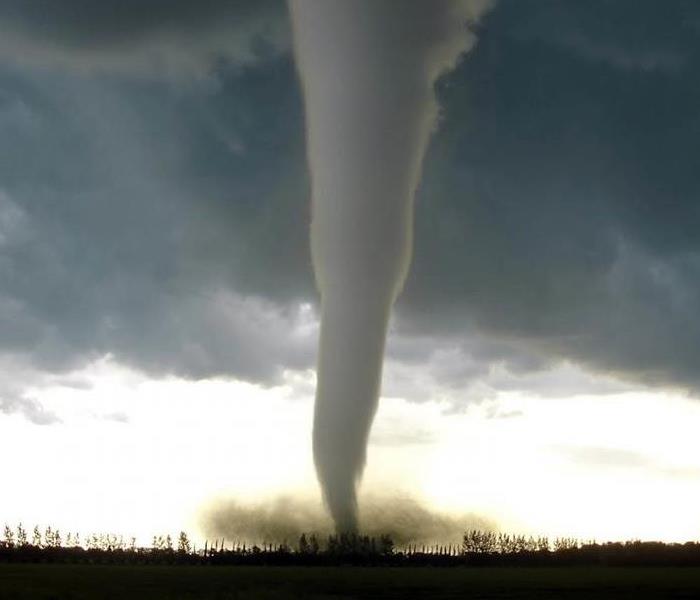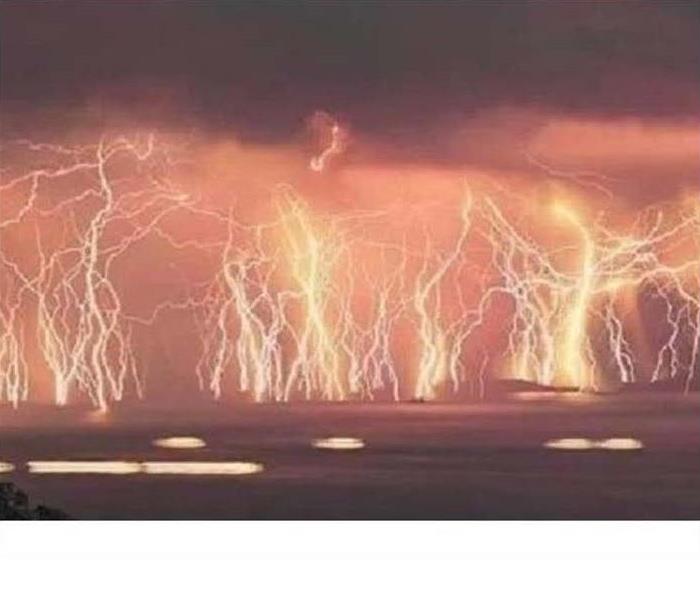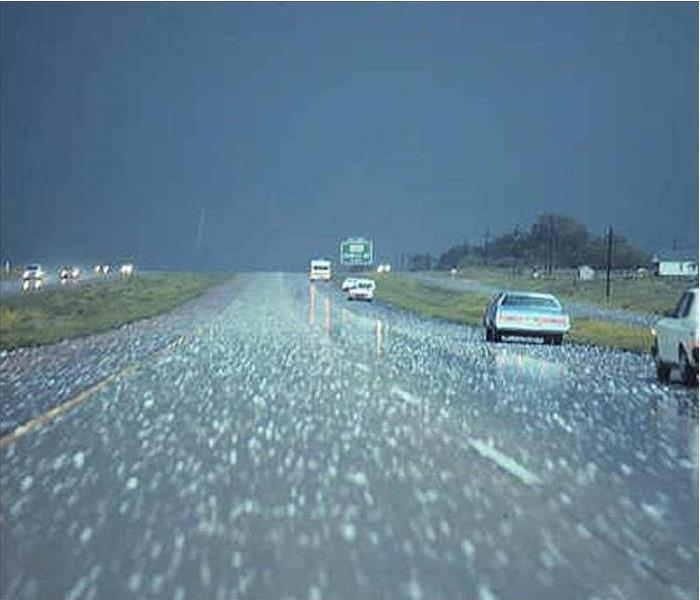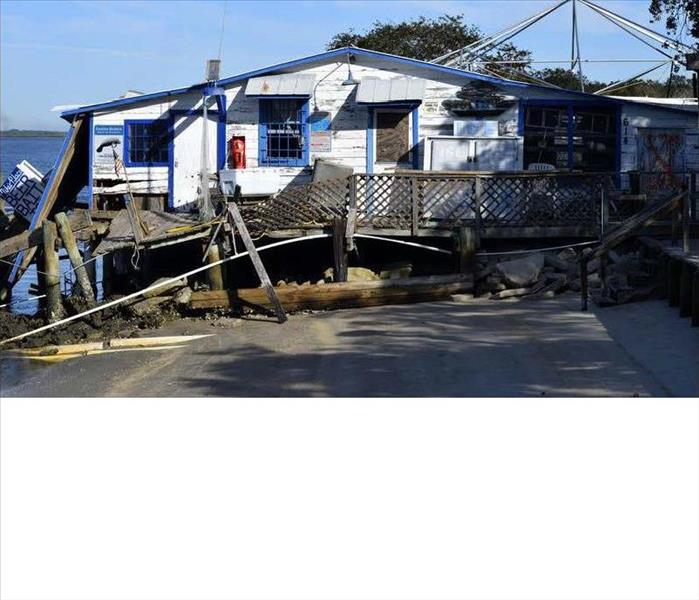Archived Storm Damage Blog Posts
Winter Storm Clean up
1/24/2025 (Permalink)
Winter weather in Virginia can be very unpredictable. Though snow has not yet been in the forecast this year, it will still prove to be beneficial to prepare your home, car and surrounding area for any impending storm. A few helpful tips for homeowners:
Salt pavement around your house: The city is pretty good with clearing the roads around your home, however any sidewalks and pathways are left up to the homeowner to clear. To make things easier on homeowners, once you are aware of any storm headed your way, spread street salt on your driveway and walkway. Placing salt down prior to any snow storm can reduce the ice that forms underneath piles of snow.
Keep a steady drip: With snow comes freezing and sometimes below freezing temperatures leaving your pipes vulnerable and likely to freeze and in turn burst. Having a slow but steady drip of warm water flow through will help keep your pipes from freezing during these conditions.
Create a winter ready emergency kit: In the event of a snow storm, the strength of it is always unpredictable. To keep you and your family safe, create and keep a winter ready emergency kit available. A few things to keep in the kit; bottled water, batteries, a functioning radio, different layers of clothing, blankets and non perishable food items.
SERVPRO of Virginia Beach has a 24/7 emergency response team that is ready to handle all storm damage in Hampton Roads, 24 hour, 365 days a year, for any residential or commercial location in the Hampton Roads area.
Hurricane Preparation: Tips from SERVPRO of Virginia Beach
7/24/2024 (Permalink)
Hurricanes can cause significant damage to your home or business, and being prepared can make all the difference. SERVPRO of Virginia Beach is here to help you stay safe and minimize damage with these essential hurricane preparation tips.
Create an Emergency Plan
- Develop a Family Plan: Ensure all family members know what to do and where to go during a hurricane. Designate a safe room in your home.
- Evacuation Routes: Familiarize yourself with local evacuation routes and have a plan for where you will go if you need to evacuate.
- Communication Plan: Establish a communication plan to stay in touch with family members during and after the storm.
Prepare an Emergency Kit
- Supplies: Stock up on non-perishable food, water, medications, flashlights, batteries, and first-aid supplies.
- Important Documents: Keep important documents in a waterproof container. Include identification, insurance policies, and medical records.
- Personal Items: Don’t forget personal hygiene items, clothing, and any necessary supplies for pets.
Secure Your Property
- Inspect Your Home: Check for any structural issues and make necessary repairs.
- Board Up Windows: Use storm shutters or plywood to protect windows and doors.
- Secure Outdoor Items: Bring in outdoor furniture, decorations, and any other items that could become projectiles in high winds.
- Trim Trees and Shrubs: Keep trees and shrubs well-trimmed to reduce the risk of branches causing damage.
Know Your Insurance Coverage
- Review Policies: Ensure you understand your homeowner’s insurance policy and what it covers in the event of a hurricane.
- Flood Insurance: Consider purchasing flood insurance if you live in a flood-prone area.
Stay Informed
- Weather Updates: Monitor local news and weather channels for updates on the storm.
- Emergency Alerts: Sign up for emergency alerts from local authorities to receive real-time information.
After the Storm
- Safety First: Avoid floodwaters and downed power lines. Wait for official word that it is safe to return to your property.
- Document Damage: Take photos and videos of any damage for insurance purposes.
- Contact SERVPRO of Virginia Beach: Our team is ready to assist with cleanup and restoration to get your life back to normal.
Contact SERVPRO of Virginia Beach
For professional assistance before, during, or after a hurricane, contact SERVPRO of Virginia Beach at 757-431-1400 or visit our website. We’re here to help you weather any storm.
Stay prepared with SERVPRO of Virginia Beach. We’re dedicated to helping you protect your home and family.
Hurricane Preparedness
6/20/2023 (Permalink)
Hurricane season started June 1st and runs through November 30th. Now is the perfect time to think about making some preparations.
Preparing in advance to deal with the unexpected can make a world of difference in how quickly and completely we can put the pieces of their lives back together. We encourage all realtors, association managers and property owners to take advantage of the no-cost emergency planning tools available from the Federal Emergency Management Agency (FEMA) (www.ready.gov/publications)
Flood Insurance
The most important thing to consider for your home is flood insurance. A common misconception is that homes that are not in a flood zone are not eligible for such coverage. That is not the case. Any home can have a flood insurance policy. Insurance is sold through local agents as part of the National Flood Insurance Program, or NFIP. Homeowners can take out separate polices to insure the structure and any contents inside. Homes that are in a designated flood zone are required to have flood insurance, and it is typically a stipulation during the sale of a house. In fact, it is recommended that homes outside of a flood zone also have coverage, especially in coastal communities, like Hampton Roads. Nationally, about 30 % of flood insurance claims come from homes that are not in a flood zone. Premiums vary by numerous factors such as location, age of the dwelling and value of insured contents inside the home. For more information about the NFIP, please visit FEMA.gov/NFIP.
Know your Zone.
The state introduced “Know Your Zone” to simplify evacuation processes when it becomes necessary. There are four zones, lettered A-D, that specify your evacuation zone based on your address and nature of the emergency event. State and local agencies will alert residents by their zones if there is a need to evacuate or shelter in place. While not every neighborhood is in a zone, that does not mean you will never have to evacuate, so you’ll still need to pay attention to official announcements and news.
To find your zone, go to KnowYourZoneVA.org. Once there, follow the on-screen instructions to enter your address and determine where you fall on the map.
Know your way out.
Have an evacuation plan, become familiar with it and make sure your family is aware of it as well. The most common routes:
- If you live north of I-264, head north and west along I-64 and across the HRBT and move inland.
- If you live south of I-264, head south and west on I-64 towards Suffolk and Highway 460 Continue to head inland and away from the coast to lessen the impact of a storm.
Keep in mind that the Chesapeake Bay Bridge Tunnel will likely be closed if an incoming storm has high winds. Avoid going north on Highway 13 and opt for the other routes.
If you choose to Shelter in Place
Have a cache of supplies that will last each member of your household, including any pets or infants, at least three days. Some of the basic supplies are:
- Water – one gallon per person, per day
- Food – Non-perishable or canned goods
- Medications and first-aid supplies
- Portable lights and batteries
- Portable radio
- Personal hygiene supplies
- Toilet paper
- Cash – to purchase one week’s worth of supplies for your household.
Should you or someone you know experience a water damage from a hurricane or a leaking pipe please do not hesitate to call SERVPRO of Virginia Beach at 757-431-1400
Storm Damage Clean Up In Virginia Beach
6/20/2023 (Permalink)
SERVPRO of Virginia Beach provides 24 hour, 365 days a year emergency board-up services for any residential or commercial location in the Hampton Roads area. Whether you experience vandalism, storm damage, or another unexpected disaster, you want to restore your property to its normal state as soon as it can be done. Boarding-up incorrectly can cause additional moisture damages, making the situation even worse. We have Class “A” Subcontractors standing by and ready to assist in any emergency. We can provide you with one-stop shopping. Leave the inconvenience of Board-ups to the Professionals at SERVPRO of Virginia Beach to make it “Like it never even happened.” Call us 757-431-1400 to ensure no further damage occurs to the structure or its contents.
Frozen Pipe Prevention
1/5/2022 (Permalink)
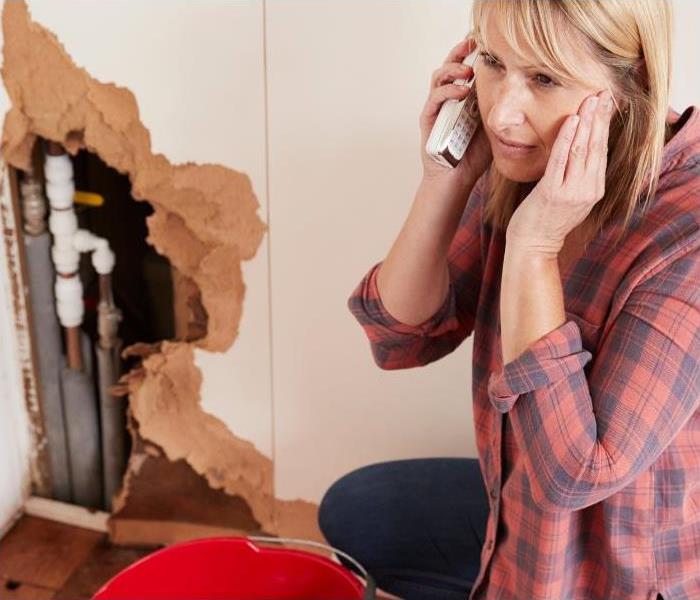 to help clean up after a water damage.
to help clean up after a water damage.
When you think of winter weather you probably think of school closings, slippery roads and a driveway to shovel. Winter weather can cause a lot more issues then those listed above. If we have below freezing temperatures for 3 days in a row you are at risk for frozen pipes, which can create a major disaster at your home or office.
Typically, frozen pipes are the ones exposed to the cold weather such as basements, attics, garages, and kitchen cabinets. A frozen pipe will usually rupture because of the backflow pressure between the blockage and the water source; this can cause catastrophic damage to your home and office if not addressed quickly.
According to the American Red Cross there several steps you can take to prevent your pipes from freezing:
- Keep your heat set both day and night
- Be sure to completely drain the water from sprinkler lines as well as outside hoses
- Open your kitchen cabinets to let the warm air to circulate near the pipes
- When weather is extremely cold, let water drip from your exposed faucets
If you experience water damage from frozen pipes, call SERVPRO of Virginia Beach at 757-431-1400
SNOW What?
1/5/2022 (Permalink)
Snow is a lot like liver and onions. You either love it or hate it. After Mondays SNOW event paralyzed vehicles for 48 miles south of Washington, leaving hundreds of motorists stranded — many for more than 24 hours without food or water while temps dropped into the teens then chances are that, you hate the fact that you weren't prepared for it, or love that you are.
S'now what...
Mother nature can be a real beast. In fact, she's a killer. And when it comes to a snow event, the best idea for safety is to stay off the roads and keep warm and safe at home. However, that isn't always possible. When you find that you must venture out on snowy and icy roads, you know to stay alert, drive a little slower, brake according to road conditions... But what if your vehicle breaks down or gets stuck and you must wait for help in a disabled vehicle in dangerously cold, wet weather?
SERVPRO of Virginia Beach wants you to be prepared in the face of any hazard that may cross your path, whether flood, fire or treacherous travel conditions.
Please take a moment to look at the list (below) of suggested items to keep in your vehicle. Just a little bit of preparation can keep a little emergency from becoming a catastrophe.
Stay warm and carry on! And tune in to AM 1310 on radio to stay alert to the latest weather conditions.
SERVPRO of Virginia Beach
757-431-1400
It's always best to call us directly
Keep These Things in Your Vehicle
Cell phone
Car charger
LED flashlight
Bag of rock salt
Shovel
Wool blankets/one for each passenger
Ice scraper
Leatherman or Swiss Army knife
Jumper cables
Two quarts of oil
Extra fuses
Fix-a-Flat
Paper towels
First aid kit
Prescription and OTC medications
Winter boots, scarves, hats and heavy winter clothes for each passenger
Water
Snack bars
Toilet paper
Music/games for young passengers
Roof Damage in Virginia Beach
11/22/2021 (Permalink)
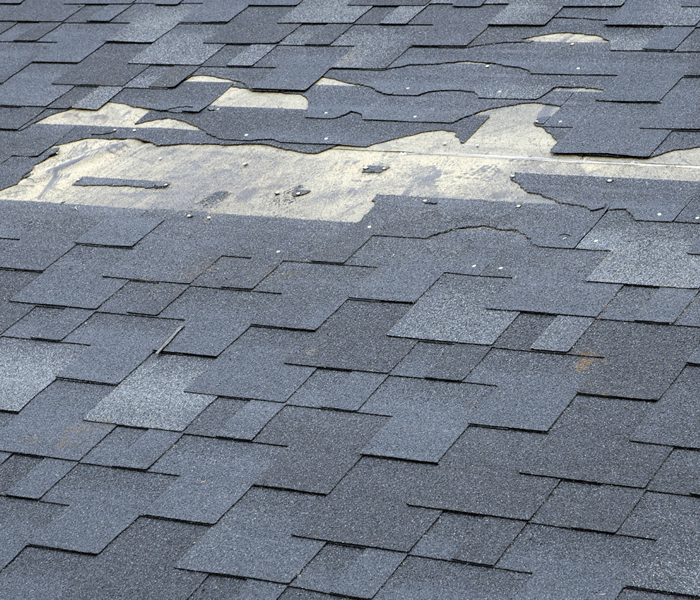 Strong winds can cause roof shingles to loosen or come off
Strong winds can cause roof shingles to loosen or come off
Virginia Beach roofs take a beating with destructive wind damage. Being on the coast means strong winds can kick up at a moment’s notice. If your roof has vulnerable spots, especially along edges and corners, strong winds can sneak under your shingles and blow them off. Once your shingles loosen, your roof is compromised.
To avoid wind damage, have your roof inspected and updated regularly. If you can, use impact-resistant materials. Also, keep the trees surrounding your home trimmed to prevent loose or dead branches from falling on or being blown onto your roof.
But what if a windstorm has blown shingles off your roof?
- Document the full extent of the damage. Do not clean up or make any temporary repairs.
- Call a roofing company or contractor to inspect the roof and get an estimate for repairs. If you aren’t sure who to use, contact your insurance adjuster for help finding a trusted contractor. Remember, you don’t have to take the first estimate you receive, so try different contractors if you’re not happy with the first estimate.
- Call your homeowner’s insurance company to report the damage and file a claim.
- Depending on the extent of the damage, contact a reliable company, like SERVPRO of Virginia Beach, to tarp your roof and prevent further damage.
If you find yourself in need of storm damage repair and cleanup, give SERVPRO of Virginia Beach a call at 757-431-1400. Representatives are available 24/7.
Before Winter Arrives. . . Don’t Let Pipes Freeze
11/22/2021 (Permalink)
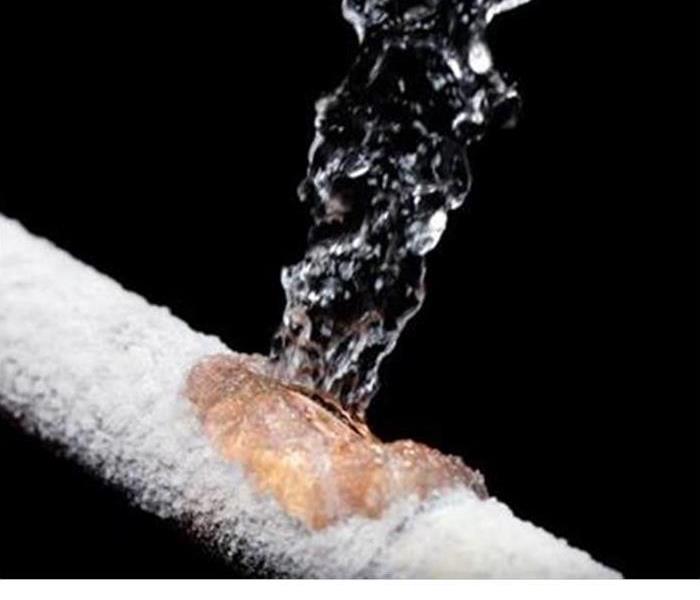 Winter weather and frozen pipe
Winter weather and frozen pipe
Before Winter Arrives. . . Don’t Let Pipes Freeze
A major home maintenance disaster is bad enough in itself, but when several disasters happen all at once, well that’s a nightmare. This is especially true when your water pipes freeze because not only do you have to call a plumber, but that crack in your pipe can spew up to 250 gallons of water a day, causing flood damage, serious structure damage, and the immediate potential for mold damage.
The causes of frozen pipes are quick and sudden drops in temperature, poor insulation, and thermostats that are set too low. Now is the time when the temps are warmer to prepare your home and here are a few preventive precaution steps.
- Insulate your pipes in your crawlspace and in your attic. Exposed pipes are vulnerable, and the more insulation, the better.
- Use approved and tested insulation products for use intended, either indoors or outdoors and make sure to follow the manufacturers’ instructions.
- Seal those leaks near or around the pipes. Electrical wiring outlets, dryer vents, and pipes can be caulked or insulated to keep out the cold air. The least little opening during severe cold weather can cause a pipe to freeze.
- Disconnect garden hoses before winter and if you can drain water from indoor pipes that lead to outside faucets and shut off the valve. This can help prevent that little bit of inside pipe from freezing.
- Keep cabinet doors open during cold spells. This allows warm air to circulate around the pipes
- Keep a slow trickle of water flowing through faucets, especially if the pipes for faucets run through unheated or uninsulated areas of your home.
SERVPRO of Virginia Beach is available 24 hours a day, 7 days a weeks should you need our services it is ALWAYS best to call us directly 757-431-1400
Steps To Protect Commercial Buildings From Wind Driven Rain
11/12/2021 (Permalink)
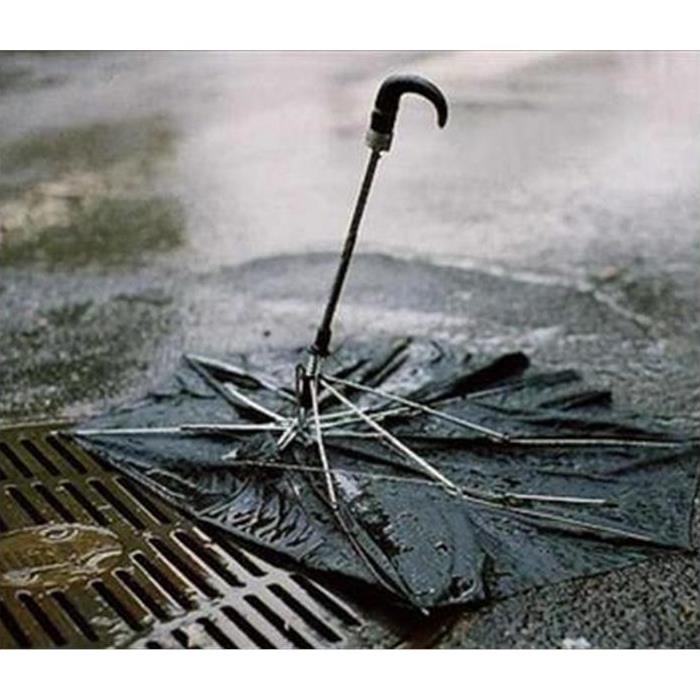 Wind driven rain
Wind driven rain
More than 60 percent of the United States is vulnerable to damage from high-wind events such as hurricanes, straight-line winds and severe thunderstorms that can produce high winds and heavy rains. Here in Hampton Roads, we are certainly susceptible to damage from strong winds and rain -- and, evidenced by recent weather events, it need not be hurricane season for us to take a wallop from wind.
Taking simple steps can make a big difference when it comes to reducing the damage caused by wind-driven rain.
Check for leaks around windows and doors, especially near corners.
Check for peeling paint, it can be a sign of water getting into the wood.
Inspect for discolorations in paint or caulking, swelling of the window or doorframe or surrounding materials.
Flashing, which is typically a thin metal strip found around doors, windows, thresholds, chimneys, and roofs, is designed to prevent water intrusion in spaces where two different building surfaces meet.
All vents, including gable vents, roof vents, and exhaust vents should be well anchored to the roof, flashed and sealed to prevent leaks.
And while the outside of the building may survive unscathed, inside water intrusion can soak documents, computers and other valuable supplies.
Water damage can threaten a business's ability to quickly bounce back after a storm. SERVPRO of Virginia Beach can help with cleanup to get your business back up and running and can assist you with future concerns by creating a plan. And it's a free service.
In addition to preparing the building against water damage, leaks can find their way in through any opening, it's important to plan for the worst before it happens. The IBHS suite of Open for Business® continuity planning and recovery tools can get you on the road to preparation. Should your building become damaged by a catastrophic event such as wind-driven rain, take appropriate actions to prevent further water damage once it is safe to do so. Water damage left unattended can result in structural failure or, potentially, mold growth. Here's what to do:
Remove standing water and all moist materials, such as wet, damaged flooring or rugs, carpet, personal property, stock, equipment or inventory, and consult SERVPRO of Virginia Beach determine the extent of the repairs necessary.
Board up damaged windows and doors.
After you have dealt with the immediate crises, contact your insurance agent to report the loss and let them know you'll be using SERVPRO of Virginia Beach for mitigation and restoration needs.
It is always best to call SERVPRO of Virginia Beach directly 757-431-1400
Winter Weather Happens in Virginia Beach
11/12/2021 (Permalink)
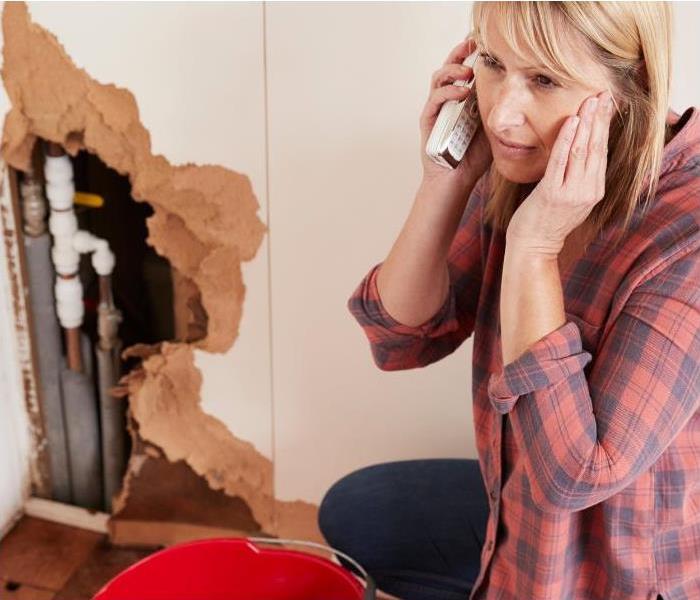 Call SERVPRO of Virginia Beach to help after frozen pipe damage.
Call SERVPRO of Virginia Beach to help after frozen pipe damage.
When you think of winter weather you probably think of school closings, slippery roads and a driveway to shovel. Winter weather can cause a lot more issues then those listed above. If we have below freezing temperatures for 3 days in a row you are at risk for frozen pipes, which can create a major disaster at your home or office.
Typically, frozen pipes are the ones exposed to the cold weather such as basements, attics, garages, and kitchen cabinets. A frozen pipe will usually rupture because of the backflow pressure between the blockage and the water source; this can cause catastrophic damage to your home and office if not addressed quickly.
According to the American Red Cross there several steps you can take to prevent your pipes from freezing:
- Keep your heat set both day and night
- Be sure to completely drain the water from sprinkler lines as well as outside hoses
- Open your kitchen cabinets to let the warm air to circulate near the pipes
- When weather is extremely cold, let water drip from your exposed faucets
If you experience water damage from frozen pipes, call SERVPRO of Virginia Beach at 757-431-1400 and let us make it "Like it never even happened."
Virginia Beach Board-up Services
1/7/2021 (Permalink)
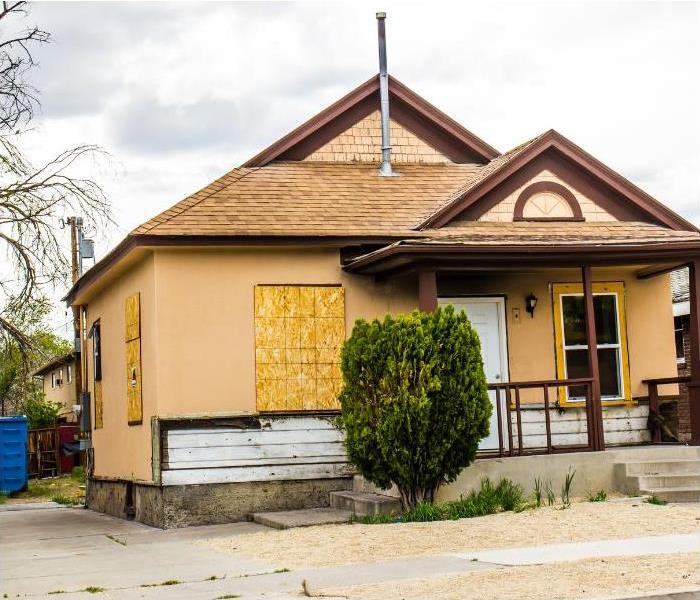 Board-up to protect from further damage or vandalism
Board-up to protect from further damage or vandalism
SERVPRO of Virginia Beach provides 24 hour, 365 day a year emergency board-up services for any residential or commercial location in the Hampton Roads area. Whether you experience vandalism, storm damage, a fire, or another unexpected disaster, you want to restore your property to its normal state as soon as it can be done. Boarding-up incorrectly can cause additional moisture damage, making the situation even worse. We have Class A Subcontractors standing by and ready to assist in any emergency. We can provide you with one-stop shopping. Leave the inconvenience of board-ups to the professionals at SERVPRO of Virginia Beach to make it "Like it never even happened." Call us at 757-431-1400 to ensure no further damage occurs to the structure or its contents.
Winter Storm Help in Virginia Beach
1/7/2021 (Permalink)
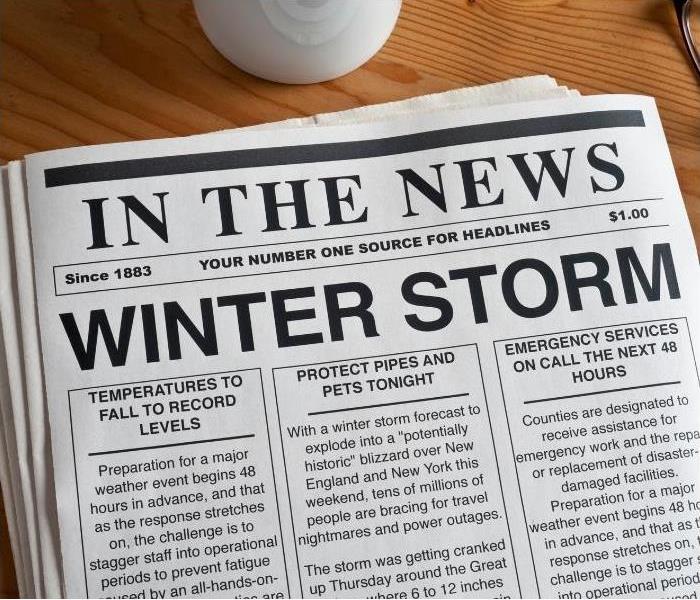 Virginia winter weather can be unpredictable
Virginia winter weather can be unpredictable
Winter weather in Virginia can be very unpredictable. Though snow has not yet been in the forecast this year, it will still prove to be beneficial to prepare your home, car and surrounding area for any impending storm. A few helpful tips for homeowners:
Salt pavement around your house: The city is pretty good with clearing the roads around your home, however any sidewalks and pathways are left up to the homeowner to clear. To make things easier on homeowners, once you are aware of any storm headed your way, spread street salt on your driveway and walkway. Placing salt down prior to any snow storm can reduce the ice that forms underneath piles of snow.
Keep a steady drip: With snow comes freezing and sometimes below freezing temperatures leaving your pipes vulnerable and likely to freeze and in turn burst. Having a slow but steady drip of warm water flow through will help keep your pipes from freezing during these conditions.
Create a winter ready emergency kit: In the event of a snow storm, the strength of it is always unpredictable. To keep you and your family safe, create and keep a winter ready emergency kit available. A few things to keep in the kit; bottled water, batteries, a functioning radio, different layers of clothing, blankets and non perishable food items.
SERVPRO of Virginia Beach has a 24/7 emergency response team that is ready to handle all storm damage in Hampton Roads, 24 hour, 365 days a year, for any residential or commercial location in the Hampton Roads area.
Strong Winds Cause Big Damage in Virginia Beach
11/23/2020 (Permalink)
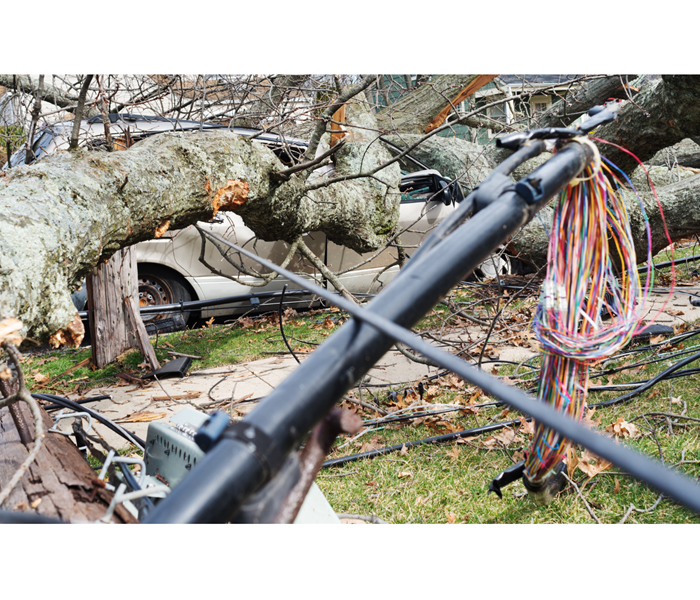 Wind can do lots of damage to your property.
Wind can do lots of damage to your property.
With strong storms comes strong winds that can cause damage to your home. There are a few things homeowners can do that will be helpful in the long run.
If nothing else, maybe you'll sleep better!
Tips for avoiding wind damage from Nationwide Insurance:
- Shingles should meet or exceed the local building code, and be rated high for wind and impact resistance.
- Make sure shingles are snugly nailed down and fitted tightly together.
- Inspect the roof sheathing to ensure it is securely nailed to avoid sections being peeled off by winds.
- Make sure the connection between the roof and walls is tight to avoid updrafts lifting off the roof.
- Check that HVAC units, skylights and pipes are tightly affixed and won't be blown off.
About walls and doors:
- Is the building well sealed to prevent wind from getting into cracks and crevices and causing interior damage?
- Check all siding and windows to ensure they are tightly attached.
- All entry doors should be triple hinged and secured with a deadbolt lock for maximum windstorm protection.
- Overhead doors should be able to withstand high winds and braced sufficiently.
Regarding outdoor areas:
- Storage sheds and outbuildings should be securely anchored.
- Evaluate everything you have stored outside, such as equipment, inventory and supplies, and make sure these are anchored or can be easily moved inside if a storm approaches.
- Make sure dumpsters, outdoor lighting fixtures and fencing are secured. Strong windstorms can pick up items, such as waste receptacles, and turn them into destructive missiles.
- Are there large shrubs and trees close to your building? Make sure they are healthy and pruned to prevent large limbs or whole trees from falling onto your building.
- Outdoor signage should be tightly anchored and secure, and designed to withstand the weather in your region. Check with your insurer to see if your sign is included in your property insurance or if you need an endorsement to cover it.
- Ensure your commercial property insurance covers any damage to your building or other business property caused by a windstorm.
About vehicles and fleet:
- If possible, store any vehicles inside a garage or storage building.
- Never park vehicles under a tree if a storm approaches.
- If you must park vehicles outdoors, be aware of things that could cause damage such as branches, lampposts and power lines.
If you encounter damage from wind or rain at your personal or business property, please call SERVPRO of Virginia Beach and let us make it "Like it never even happened."
Virginia Beach Tornado Damage
11/23/2020 (Permalink)
 Hampton Roads is no stranger to the damage of tornadoes.
Hampton Roads is no stranger to the damage of tornadoes.
Most violent tornadoes come from supercells, large thunderstorms that have winds already in rotation. About one in a thousand storms becomes a supercell, and one in five or six supercells spawns off a tornado. Tornado season begins in early spring for the states along the Gulf of Mexico. The season follows the jet stream—as it swings farther north, so does tornado activity. May generally has more tornadoes than any other month, but April's twisters are usually more violent. Although they can occur at any time of the day or night, most tornadoes form in the late afternoon. By this time the sun has heated the ground and the atmosphere enough to produce thunderstorms. Tornadoes form when warm, humid air collides with cold, dry air. Twisters are usually accompanied or preceded by severe thunderstorms and high winds. Hail is also common. Once a tornado hits the ground, it may live for as little as a few seconds or as long as three hours.
What is a State of Emergency for Hampton Roads: A state of emergency allows state agencies to perform actions, that normally would not be permitted, in the interest of quickly getting assistance to local governments, and in turn Virginia residents.
SERVPRO of Virginia Beach is well-versed to handle all tornado damage in Hampton Roads, 24 hour, 365 days a year emergency for any residential or commercial location in the Hampton Roads area. We have Class “A” Subcontractors standing by and ready to assist in any emergency. We can provide you with one-stop shopping. Leave the hassle of repairing the damage to the professionals at SERVPRO of Virginia Beach and make it "Like it never even happened." Call us 757-431-1400 to ensure no further damage occurs to the structure or your contents.
How to Look for Storm Damage in Virginia Beach
11/16/2020 (Permalink)
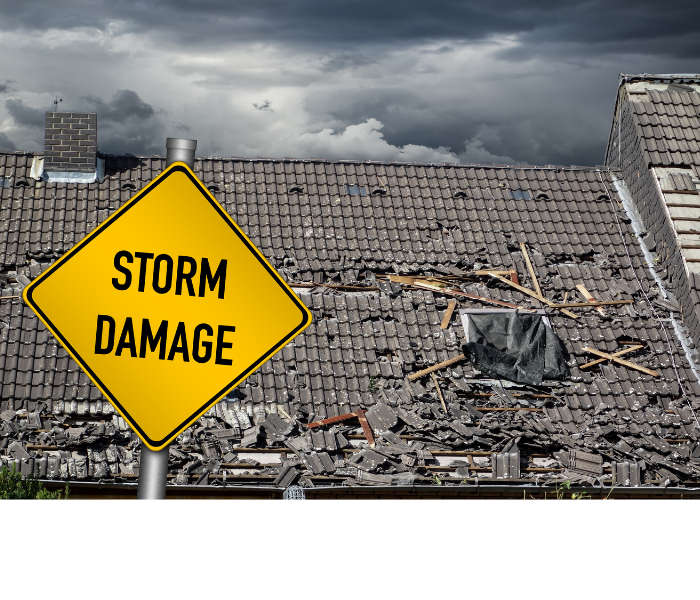 Roof damage after a severe storm.
Roof damage after a severe storm.
How to look for storm damage
- Roof: Look for shingles that have discoloration, tearing, or even holes in them. These can all be signs that your roof has been damaged. Another sign is if there are leaks in your roof or your ceiling.
- Gutters: After a hailstorm, looking for dents or dings can also give you a better picture of what the storm did to the rest of your home. Your gutters can also give you insight to whether you have roof damage. Check to see if there are granules from the asphalt shingles in your gutter.
- Windows: Look at each of the windows at your homes and note any signs of shattered or broken windows and frame damage. This is especially important after a hailstorm or a strong wind storm.
- Exterior: Not only is it important to look at the siding of your home to check for damage, it is also important that you check any appliances. Inspect your AC/HCAC unit as well as items such as a barbeque grill.
After your inspection, if you notice any signs of storm damage follow up by checking the area for signs of mold, mildew, pests or other secondary damage. If damage has occurred have it repaired immediately. Call SERVPRO of Virginia Beach at 757-431-1400 for any restoration needs you may have.
Winter Weather in Virginia Beach
11/16/2020 (Permalink)
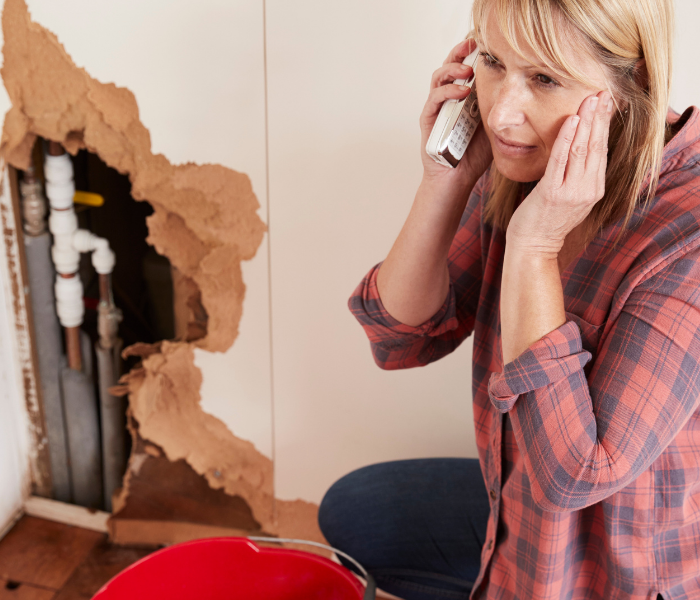 Call SERVPRO of Virginia Beach to help clean up after a water damage.
Call SERVPRO of Virginia Beach to help clean up after a water damage.
When you think of winter weather you probably think of school closings, slippery roads and a driveway to shovel. Winter weather can cause a lot more issues then those listed above. If we have below freezing temperatures for 3 days in a row you are at risk for frozen pipes, which can create a major disaster at your home or office.
Typically, frozen pipes are the ones exposed to the cold weather such as basements, attics, garages, and kitchen cabinets. A frozen pipe will usually rupture because of the backflow pressure between the blockage and the water source; this can cause catastrophic damage to your home and office if not addressed quickly.
According to the American Red Cross there several steps you can take to prevent your pipes from freezing:
- Keep your heat set both day and night
- Be sure to completely drain the water from sprinkler lines as well as outside hoses
- Open your kitchen cabinets to let the warm air to circulate near the pipes
- When weather is extremely cold, let water drip from your exposed faucets
If you experience water damage from frozen pipes, call SERVPRO of Virginia Beach at 757-431-1400 and let us make it "Like it never even happened."
Storm Damage Cleanup
1/9/2020 (Permalink)
SERVPRO of Virginia Beach provides 24 hour, 365 days a year emergency board-up services for any residential or commercial location in the Hampton Roads area. Whether you experience vandalism, storm damage, or another unexpected disaster, you want to restore your property to its normal state as soon as it can be done. Boarding-up incorrectly can cause additional moisture damages, making the situation even worse. We have Class “A” Subcontractors standing by and ready to assist in any emergency. We can provide you with one-stop shopping. Leave the inconvenience of Board-ups to the Professionals at SERVPRO of Virginia Beach to make it “Like it never even happened.” Call us 757-431-1400 to ensure no further damage occurs to the structure or its contents.
Winter Storm Help
1/9/2020 (Permalink)
Winter weather in Virginia can be very unpredictable. Though snow has not been on the forecast this year it will still prove to be beneficial to prepare your home, car and surrounding area for any impending storm. A few helpful tips for homeowners;
Salt pavement around your house: the city is pretty good with clearing the roads around your home, however any sidewalks and pathways are left up to the homeowner to clear. To make things easier on homeowners, once you are aware of any storm headed your way spread street salt on your driveway and walkway. Placing salt down prior to any snowstorm can reduce the ice that forms underneath piles of snow.
Keep a steady drip: With snow comes freezing and sometimes below freezing conditions leaving your pipes vulnerable and likely to freeze and in turn burst. Having a settle but steady drip of warm water flow through will help keep your pipes from freezing during these conditions.
Create a winter ready emergency kit: In an event of a snow storm the strength of it is always unpredictable. To keep you and your family safe, create and keep a winter ready emergency kit available. A few things to keep in the kit; bottled water, batteries, a functioning radio, different layers of clothing, blankets and non perishable food items.
SERVPRO of Virginia Beach has a 24/7 emergency response team that is well-versed to handle all storm damage in Hampton Roads, 24 hour, 365 days a year emergency for any residential or commercial location in the Hampton Roads area.
Winter Storm Challanges
11/25/2019 (Permalink)
With Winter clashing with Fall it will be helpful for homeowners to prepare for any impending Winter weather. Living in Virginia, its safe to say Winter weather could go either way. However which way it swings it would do homeowners good to prepare for anything.
Prepare for power outages: Extreme freezing conditions, strong winds and snow pile ups can cause for power outages. Depending on the impact of the storm this could cause power lines to be down for days at a time. With the possibility of lingering power outages, homeowners should keep a storm bag ready. Useful things to have in a storm bag would include a flashlight, extra batteries, non perishable food items, water, extra clothes and blankets for both you and your family.
Stay off roads: During such bad conditions the most important things for homeowners to remember is to stay safe. If evacuation is being called for your area make sure you and your family are evacuated before the storm hits. Freezing weather mixed with snow can cause black ice to sit on the roads. Black ice is virtually invisible, but what you can't see can cause a lot of damage.
Keep snow material on hand: In the stillness after a huge storm, there are a few things you as a homeowner can do to prepare your home. Keep a shovel and salt for ice on hand. In the days after a huge storm the city is working to clean the roads that surround your home, as a homeowner you have to clean any sidewalks or driveways that lead up to your home. The easiest thing to do, once it is safe to return outside is to shovel the snow off your driveways and sidewalks and sprinkle a layer of salt on the ground to gain traction and to speed up melting the ice.
SERVPRO of Virginia Beach has a 24/7 emergency response team that is well-versed to handle all storm damage in Hampton Roads, 24 hour, 365 days a year emergency for any residential or commercial location in the Hampton Roads area.
What Storm Damage Looks Like
11/25/2019 (Permalink)
A terrible storm can cause an immense amount of damage to your home. Some visible to the naked eye some not. Below are a few things homeowners should look for.
- Roof: Look for shingles that have discoloration, tearing, or even holes in them. These can all be signs that your roof has been damaged. Another sign is if there are leaks in your roof or your ceiling.
- Gutters: After a hail storm, looking for dents or dings can also give you a better picture of what the storm did to the rest of your home. Your gutters can also give you insight to whether you have roof damage. Check to see if there are granules from the asphalt shingles in your gutter.
- Windows: Look at each of the windows at your homes and note any signs of shattered or broken windows and frame damage. This is especially important after a hail storm or a strong wind storm.
- Exterior: Not only is it important to look at the siding of your home to check for damage, it is also important that you check any appliances. Inspect your AC/HCAC unit as well as items such as a barbeque grill.
SERVPRO of Virginia Beach has a 24/7 emergency response team that is well-versed to handle all storm damage in Hampton Roads, 24 hour, 365 days a year emergency for any residential or commercial location in the Hampton Roads area.
Wind Pickup
11/25/2019 (Permalink)
With strong storms comes strong winds that can cause damage to your home. There are a few things homeowners can do that will be helpful in the long run.
If nothing else, maybe you'll sleep better!
Tips for avoiding wind damage from Nationwide Insurance
- Shingles should meet or exceed the local building code, and be rated high for wind and impact resistance.
- Make sure shingles are snugly nailed down and fitted tightly together.
- Inspect the roof sheathing to ensure it is securely nailed to avoid sections being peeled off by winds.
- Make sure the connection between the roof and walls is tight to avoid updrafts lifting off the roof.
- Check that HVAC units, skylights and pipes are tightly affixed and won't be blown off.
About walls and doors:
- Is the building well sealed to prevent wind from getting into cracks and crevices and causing interior damage?
- Check all siding and windows to ensure they are tightly attached.
- All entry doors should be triple hinged and secured with a deadbolt lock for maximum windstorm protection.
- Overhead doors should be able to withstand high winds and braced sufficiently.
Regarding outdoor areas:
- Storage sheds and outbuildings should be securely anchored.
- Evaluate everything you have stored outside, such as equipment, inventory and supplies, and make sure these are anchored or can be easily moved inside if a storm approaches.
- Make sure dumpsters, outdoor lighting fixtures and fencing are secured. Strong windstorms can pick up items, such as waste receptacles, and turn them into destructive missiles.
- Are there large shrubs and trees close to your building? Make sure they are healthy and pruned to prevent large limbs or whole trees from falling onto your building.
- Outdoor signage should be tightly anchored and secure, and designed to withstand the weather in your region. Check with your insurer to see if your sign is included in your property insurance or if you need an endorsement to cover it.
- Ensure your commercial property insurance covers any damage to your building or other business property caused by a windstorm.
About vehicles and fleet:
- If possible, store any vehicles inside a garage or storage building.
- Never park vehicles under a tree if a storm approaches.
- If you must park vehicles outdoors, be aware of things that could cause damage such as branches, lampposts and power lines.
Should you encounter damage from wind or rain at your personal or business property, please call SERVPRO of Virginia Beach and let us make it Like it never even happened.
Storm Damage? Tips for Homeowners
11/21/2019 (Permalink)
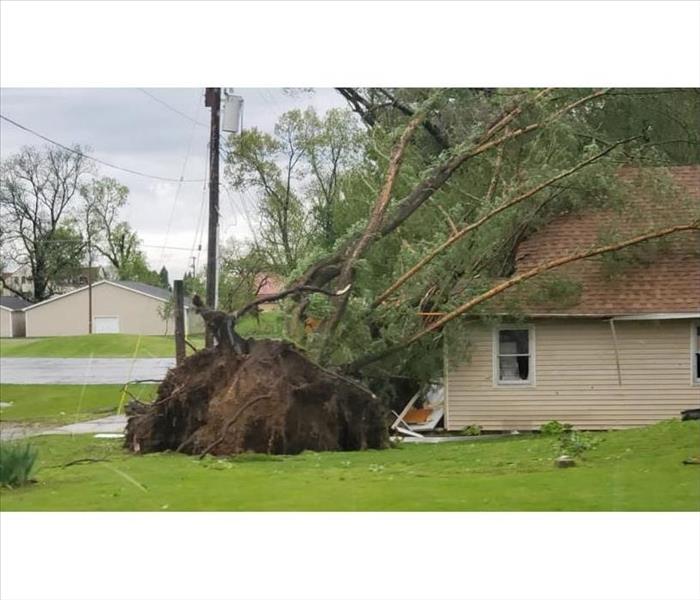 A tree falling on a house
A tree falling on a house
The damage a storm can cause is unsettling for many homeowners. A storm with strong winds and heavy rain can cause tremendous damage to homes that may cause homeowners to react quickly. The days that follow after a huge storm are the most crucial in returning to normalcy. Here are a few tips for homeowners that will help them transition back into their normal day to day lives.
- Remember, stay safe: Avoid power lines and large pools of water. With large pools of standing water mold may and can appear. It would do homeowners good to have professionals come out to access any damages before returning to their homes.
- Document the damage and contact your insurance company: It’s always helpful to have pictures securred of your home before an impending storm. After the storm if your home is safe to enter document any damages and contact your insurance company immediately, they will help you act fast and stop any further damages that may occur.
- Plan, plan, plan: Once you are aware that a storm is coming to your area have a full proof plan that will keep you and your family safe. Have an evacuation plan in motion that you and your family have practiced. Have a safe place where you and your family can go, an expense plan and a plan to get your families life back on track.
During this time of need, make SERVPRO of Virginia Beach your first call to help you and your local insurance agent assess the damage. We will work for you to restore your property and your life to make it "Like it never even happened."
Virginia Beach Tornado Facts
1/10/2019 (Permalink)
Most violent tornadoes come from supercells, large thunderstorms that have winds already in rotation. About one in a thousand storms becomes a supercell, and one in five or six supercells spawns off a tornado. Tornado season begins in early spring for the states along the Gulf of Mexico. The season follows the jet stream—as it swings farther north, so does tornado activity. May generally has more tornadoes than any other month, but April's twisters are usually more violent. Although they can occur at any time of the day or night, most tornadoes form in the late afternoon. By this time the sun has heated the ground and the atmosphere enough to produce thunderstorms. Tornadoes form when warm, humid air collides with cold, dry air. Twisters are usually accompanied or preceded by severe thunderstorms and high winds. Hail is also common. Once a tornado hits the ground, it may live for as little as a few seconds or as long as three hours.
What is a State of Emergency for Hampton Roads: A state of emergency allows state agencies to perform actions, that normally would not be permitted, in the interest of quickly getting assistance to local governments, and in turn Virginia residents.
SERVPRO of Virginia Beach is well-versed to handle all Tornado damage in Hampton Roads, 24 hour, 365 days a year emergency for any residential or commercial location in the Hampton Roads area. We have Class “A” Subcontractors standing by and ready to assist in any emergency. We can provide you with one-stop shopping. Leave the hassle of repairing the damage to the Professionals at SERVPRO of Virginia Beach and make it “Like it never even happened.”, call us 757-431-1400 to ensure no further damage occurs to the structure or your contents.
Severe Weather Facts and Myths for Virginia Beach
11/23/2018 (Permalink)
Myth: Highway and interstate overpasses are safe shelters against a tornado.
Fact: Overpasses can concentrate the tornado winds, causing them to be significantly stronger. This places the people under them in an even more dangerous situation. In recent years, several people seeking shelter beneath overpasses have been killed or severely injured. Being above ground level during a tornado is dangerous.
Myth: The low pressure with a tornado causes buildings to explode. Opening the windows will equalize the pressure, saving the building.
Fact: Opening the windows in an attempt to equalize pressure will have no effect. It is the violent winds and debris that cause most structural damage. It is more important for you to move to a safe area away from windows and exterior walls. With a tornado, every second counts, so use your time wisely and take cover.
Myth: Thunderstorms and tornadoes always move from west to east.
Fact: More often than not, thunderstorms move from west to east. Conditions in the atmosphere dictate how and where storms will move, and it can be in any direction. Tornadoes have been known to act erratic, and can change directions and speed very quickly. Never try to outrun a tornado in a vehicle.
Myth: It’s not raining here, and skies above me are clear, therefore I am safe from lightning.
Fact: Lightning can strike many miles away from the thunderstorm. If storms are in your area, but skies happen to be clear above you, that certainly does not imply you are safe from lightning. Though these “Bolts from the Blue” are infrequent, lightning strikes 10 to 15 miles away from the storm are not out of the question.
Myth: Since I am inside my house and out of the storm, I am completely safe from lightning.
Fact: Just because you have taken shelter inside, you are not automatically safe. While inside waiting out a storm, avoid using the telephone or electrical appliances and do not take showers or baths. Also stay away from doors and windows. Telephone lines, cords, plumbing, even metal window and door frames are all lightning conductors and pose a threat
Myth: Large and heavy vehicles, such as SUVs and pickups, are safe to drive through flood waters.
Fact: It is a common belief that the larger the vehicle, the deeper the water it can drive through. Many people do not realize that two feet of water can float most vehicles, including SUVs and pickups. If the water is moving rapidly, vehicles can be swept away.
Myth: Flash floods only occur along flowing streams.
Fact: Flash floods can and do occur in dry creek or river beds as well as urban areas where no streams are present.
Virginia Beach Storm Facts, Tips & Safety
11/23/2018 (Permalink)
Severe Thunderstorm Facts
Thunderstorms are defined as storms that produce thunder and lightning. Severe thunderstorms may also produce:
- Rain
- High winds
- Sleet or snow
It’s important to note that thunderstorms do not always produce moisture. A storm in which you see lightning and hear thunder but never feel a drop of water is known as a “dry” thunderstorm. Thunderstorms that produce hail and tornadoes are known as “supercell” storms. Storms occur either in clusters or lines; therefore, they may present as a single thunderstorm or as multiple thunderstorms hitting one after the other.
Causes
Thunderstorms are caused when moisture from the lower or mid-level part of the atmosphere mixes with warm, unstable air from the ground. Moisture and air then push upwards into the higher atmosphere to form clouds that produce thunder and lightning, as well as potential precipitation. Spring, summer and fall are most conducive to thunderstorms because the sun heats the ground and moisture is more perceptible in the air, especially in humid climates.
Thunderstorms must also be lifted to begin their formation. Some sources of lift include:
- More heat on the ground than in the air
- Changes in atmospheric conditions near mountains
- Weather front changes caused by clashing cold and hot air
- Drylines, or when moist and dry air clash
- Land or sea breezes
Any of these situations can immediately create a thunderstorm without warning, even in the middle of a clear blue day. In many cases, these storms will also be accompanied by lightning. Most will not come with hail or tornadoes, unless they occur in tornado-prone states such as Kansas, Oklahoma, Texas and Missouri.
Return to Top
Thunderstorm Statistics
Severe thunderstorms are responsible for a significant number of injuries, fatalities and property damage claims across the United States every year. According to statistics reported by the National Oceanic and Atmospheric Administration (NOAA) in 2013:
- Lightning accounted for 23 fatalities, 145 injuries and $23.9 million in property damage.
- Tornadoes caused 55 fatalities, 756 injuries and $3,642.2 million in property damage.
- High winds resulted in 17 deaths, 121 injuries and $626.8 million in property damage.
- Hail led to 4 injuries and $1,234.5 million in property damage.
- Flash flooding ended in 60 deaths, 25 injuries and $956.9 million in property damage.
It’s estimated that at least 867,000 people are affected by thunderstorms every year, with lightning accounting for at least 300 injuries and roughly 60 fatalities. Moreover, at least 16 million thunderstorms occur worldwide every year — and at least 2,000 storms are causing damages and injuries around the world at any given time.
Return to Top
Preparing for Severe Thunderstorm Conditions
Severe thunderstorms can cause significant physical harm as well as damage to your home and land; therefore, it’s imperative to take measures to protect yourself. Some homeowners might invest in lightning rods to better defend their homes against a surge. There are also whole-house surge protectors so you don’t have a power outage during a severe thunderstorm. There are many other types of defenses you can put in place to protect your home against severe thunderstorms. For example, here’s how to prepare for hail, winds, tornadoes and floods.
Hail Damage
If you have a car, it’s imperative that you park it in your garage before a severe thunderstorm. Otherwise you could be looking at dents, cracks in the windshield and potentially broken glass on the driver or passenger’s side. While hail is not the most common precipitation to accompany a severe thunderstorm, it can happen. You could also:
- Install wind shutters (i.e. hurricane shutters), designed to defend against high winds and hail.
- Purchase & install pressure or high impact windows.
- Secure doors with heavy-duty bolts at the top and bottom of the door frame.
Hail can cause damage to many parts of the home, but it most commonly hits the roof the hardest. A damaged shingle, in particular, can allow water to get through to the roof deck and cause harm to your ceiling and support beams. This will eventually lead to more leaks in your roof, stains on the ceiling and walls, and potential flooding.
The cost to repair a roof following such damages will be expensive, but holding off could lead to even more costly repairs down the road. It’s best to perform repairs as quickly as possible. The two types of repairs you might be faced with include:
- Asphalt: Hail damage will appear as a dark spot or bruise because the granules will be missing. Look for holes, cracks or absent shingles. Repair immediately.
- Other shingles: Wood, metal, tile and other shingles will be hit hard by hail as well. Cracked, missing or broken shingles will allow leaking, so you’ll need a roofer in immediately to fix the problem.
Wind Damage
Winds can reach at least 300 miles per hour during a severe thunderstorm, which can rip siding off your home and exacerbate the pelting of your exterior with hail and debris as well. Wind damage repairs can cost thousands of dollars, depending on the extent of the injury. While you can’t prepare for flying debris from other houses, you can minimize damage by curtailing debris in your own yard. To prevent wind damage, you can:
- Trim back tree branches to prevent fallen limbs.
- Secure window shutters to defend against debris.
- Tie down anything that could fly away and hit the siding or the roof.
If your siding is looking worse for wear, have a siding professional come out to repair it. It could make the difference in whether you’re left with an intact home exterior after a storm or not.
Tornado Damage
Tornado damage occurs following high winds from blowing debris. While you can’t do a lot to prepare your home for a tornado, it helps to trim tree branches back from your roof and windows. You can also reinforce your roof to better handle high winds:
- Shake roof: Add more nails.
- Slate roof: Seal down with cement.
- Tile roof: Place a steel strap over the tiles.
- Asphalt roof: Nothing can be done, but inspect after.
You can also invest in a storm cellar, which is built underground and allows great defense against high winds during a tornado. A storm shelter is built close to the home so you have easy access during a tornado and don’t have to run far for safety. A storm cellar door is built at an angle so that debris blows over the door. This allows for debris to roll over the door rather than trap it, so you can get in and out easily. The confines of a storm cellar for a family is around 8 by 12 feet with an arched roof. It’s made of cement blocks and rebar to ensure maximum defenses.
Flood Damage
Flooding can cause tens of thousands of dollars in damages to your home. To prepare your home for potential flooding, ensure that the ground is sloped away from your foundation. This will defend your home against water buildup. Also, regularly maintain any storm drains, gutters and downspouts. Other tips include:
- Cleaning gutters regularly
- Check and clean storm drains on a bimonthly basis
- Clean the storm drain cover
- Check window wells and sump pumps
- Construct barriers to stop flood water from getting into your home.
- Raise your heating system to a higher floor level to avoid flood water.
- Seal cracks in the basement walls.
Return to Top
Warnings, Alerts & Where to Go
You will see severe thunderstorm warnings and alerts appear throughout the span of the storm, whether it’s on the radio, TV or your smartphone. You can find warnings:
- In emergency notifications on smartphones
- On weather apps as alerts in real time
- On the radio from the National Weather Association
- On TV at the bottom as a grey moving bar with affected counties, times
When you see a severe thunderstorm warning in effect for your area, you need to stay indoors until at least 30 minutes after the last clap of thunder. Stay away from windows and doors, in case they happen to blow open or break in high wind conditions. Stay out of water in case of lightning. If you’re driving when you get the alert, head home if you’re close or get off the road immediately.
Return to Top
Storm Recovery and Damage Repair
After a severe thunderstorm hits your home, you could be looking at a few hundred dollars worth of simple repairs — broken windows, landscape upkeep and debris removal, for example — or you could be looking at thousands of dollars in repairs due to hail damage and flooding. Survey the extent of the damage and determine whether it will cause additional long-term issues; immediately fix anything that will. Here are some common post-storm damages and how to address them:
Roof Damage
Broken tree branches, high winds, flying debris and hail can cause roof damage that will need to be addressed following a severe thunderstorm. Some signs of roof damage after a storm include:
- Holes
- Split seams
- Missing, bruised or dented shingles
- Cracked or broken tiles
- Granules in the gutters
- Leaks
- Dents on the vents and gutters or roof flashing
It’s imperative that you have a roofing contractor fix your roof following a severe thunderstorm. Otherwise, these damages could lead to expensive interior problems like attic flooding, ceiling stains, and mold. In worst-case scenarios — those in which your roof is old and cannot handle the high winds or hail storms — your roof may cave in on itself. This is uncommon, but you do run the risk of having to replace your roof if it’s reaching the 15-20 year mark around the time of a severe thunderstorm.
Siding
Weather associated with severe thunderstorms can also significantly impact the exterior and siding of your home, causing:
- Cracks that run parallel to the siding
- Chips or breaks in siding
- Breaks or holes that are punched into the siding by hail and debris
- Dings and dents, most commonly found in aluminum siding
- Paint damage such as chips, cracks and color changes or small black marks
If your siding shows cracks, chips, or dings and dents, have it repaired immediately to prevent pests, insects or climate conditions from further impacting your home. Breaks and holes, in particular, negate the siding’s ability to defend your home entirely. Such damage will require siding to be replaced by a contractor — in parts or in whole — which could cost thousands of dollars. Paint damage is the least of concerns because it’s a cosmetic injury rather than a functional one.
Windows and Doors
Windows and doors bear the brunt of severe thunderstorms’ debris and high winds, making them highly susceptible to damages. Some damages you’ll see after a storm might include:
- Cracked or splitting doors and frames
- Broken glass or shattered windows
- Debris embedded in a door or window
- Paint chipped or cracking around a door or window
Contractors recommend taking the following steps to protect your windows and doors against severe thunderstorms.:
- Window film: This keeps window glass from shattering.
- Plywood boards: Install over windows before a storm.
- Storm shutters: Shutters defend against high winds and debris.
- High impact glass: Impact glass breaks into two pieces rather than shattering when hit by debris.
Tree Damage
While you can trim your trees back before a storm, there’s still a chance that high winds, flying debris and hail will cause them to bend, twist and break during a severe thunderstorm. There are six different ways a tree can be damaged during a storm:
- Blow-over: A tree is pushed over by high winds.
- Stem failure: Stems break under high winds because of old wounds and pest damage.
- Crown twist: Tree crowns will twist and split under high winds because of poor maintenance, or because they’re lopsided.
- Root failure: Poor anchorage to the ground will cause the root to pull up or snap, and the tree will fall or lean over.
- Branch failure: Branches will break off from the tree because they’re poorly attached in the first place.
- Lightning: Lightning will hit the tree and cause small explosions down the line of the tree, causing it to break and fall.
There’s not much a homeowner can do to prep a tree for potential damage except provide good care and maintenance. Trim trees on a regular basis and try to keep branches away from your home and power lines.
Flood Damage
If your home is flooded following a severe thunderstorm, there are various steps you can take to recover your home. It’s going to be a long process, involve a lot of tearing up, remodeling and time, but your home will go back to its original state eventually. Some recommendations from the CDC include:
- Wear safety gear.
- Get rid of anything that can’t be cleaned (bedding, fabric flooring, upholstery, toys, linens)
- Throw away drywall and insulation that’s wet.
- Deep clean and scrub hard surfaces with hot water and dish detergent.
- Use fans, A/C units and dehumidifiers to speed the drying process.
- Wash all clothing touched by flood water with hot water and laundry detergent.
Be aware of electrical power lines, natural gas lines, frayed wires and any other hazards from flooding that could injure you. You should check with the gas company or the fire department before returning to your home to avoid injury. Do not return to your home during the day to avoid any accidents from being unable to see. You shouldn’t be allowed to return until the police or fire department say it’s okay. You should also not wade in standing water or around downed power lines, just in case.
If you need help with the big part of the recovery job — pulling up carpet, taking down drywall, removing appliances, so forth — you can call in a disaster recovery contractor to help you. These professionals are licensed and experienced in handling situations like flood recovery and know where to start. They can also look out for disaster-specific issues like mold, foundation issues and the like.
Return to Top
Top States for Thunderstorms
Some states are more prone to severe thunderstorms than others, which means homeowners in such states need to be better prepared. According to a report on WeatherBug, in 2013 the top states for severe thunderstorms between March 1 and June 17 included:
- Texas: 922 events*
- Oklahoma: 725 events
- Kansas: 652 events
- Missouri: 515 events
- Illinois: 456 events
- Nebraska: 405 events
- Iowa: 403 events
- New York: 252 events
- Mississippi: 233 events
- Virginia: 232 events
- Louisiana: 223 events
*Note: events are defined as severe thunderstorms
The most active states — Texas, Oklahoma, Kansas and Missouri — received 300 severe thunderstorm alerts per week.
Return to Top
Thunderstorm Safety Tips and Prevention
To keep your home and family safe before and during a thunderstorm, it’s imperative that you take precautionary measures — especially if you live in an area prone to storms.
To prepare for a thunderstorm, the Federal Emergency Management Association (FEMA) recommends:
- Putting together an emergency kit and family plan
- Removing debris and branches
- Securing outdoor objects that could blow away or damage the home
- Staying inside your home
- Closing all exterior windows and doors
- Unplugging all electronic equipment before the storm.
While there isn’t much you can do to prevent a severe thunderstorm, you can keep the damages to a minimum by securing as much in your home as possible and reinforcing the defenses around your home exterior. Tie down your roofing or seal it with mortar, call in siding professionals and clean up all the debris around your house.
There are storm damage professionals who can come in following a natural disaster and help with the recovery. While they don’t fix everything, they can help you start the process. If you want to read more about what they do, read this FAQ from the National Storm Damage Center.
How to Keep Your Insurance Down
Standard homeowner policies cover your home and what’s in it. You should be covered for storm damages and major natural disasters, including severe thunderstorms; however, flooding is not generally covered. Storm-resistance improvements that will lower your premiums include:
- Impact-resistant shingles
- High impact glass
- Storm shutters
Always file a claim following a severe thunderstorm if your home is extensively damaged.
Fun Storm Facts for Virginia Beach
11/23/2018 (Permalink)
Are you afraid of storms, or do you embrace them? Whichever side you fall on, we all have some sort of respect for storms. They can cause great damage, paint beautiful pictures across the sky, alter any outdoor plans, and completely turn a day around. Although you’ve probably experienced many thunderstorms in your life, you might not know a whole lot about them. In today’s post, we’re going to share some fun storm facts that you may not have known!
- The typical thunderstorm is 15 miles in diameter!
- The typical thunderstorm lasts about 30 minutes.
- About 1,800 thunderstorms are happening around the world at any given moment.
- Lightning kills more people than tornadoes every year.
- A severe storm “watch” means that a serious storm has the potential to develop, but has not developed yet. However, a sever storm “warning” means that a storm has developed and been sighted.
- About 10% of storms are classified as “severe”.
- If you’re ever heard the term the “four horsemen” of thunderstorms, it’s referring to wind/tornadoes, hail, floods, and lightning.
- Thunderstorm clouds grow to heights of above 20,000 feet!
- A “derecho” is a type of severe storm that lasts a long time, covers a great distance, and involves serious wind.
- Wind speeds can be up to 120 mph in thunderstorms, even without a tornado.
- A massive hailstorm in Munich, Germany, in 1984 caused over $1 billion worth of damage.
- In 1933, huge hailstones were reported to have fallen around a city in Massachusetts, containing fresh, frozen ducks inside.
4 Facts About Hurricanes for Virginia Beach
11/21/2018 (Permalink)
Hurricane season runs from June through November. Here is Virginia Beach, we thankfully did not get hit this year. However our southern neighbors in North Carolina did and it was devastating.
Living near the coast in the south, most people are all too familiar with the hurricane season and the tropical storms that come with it. But what about hurricane damage to your home? If you haven’t had hurricane damage before, here are 4 facts about hurricane damage you need to know before the storm hits.
1. Primary Causes of Hurricane Damage
The primary cause of hurricane damage to homes is damage from high wind and flooding from the torrential rains.
2. What the Wind Does
The wind can cause damage to siding and it can break windows and blow in garage doors. Broken and downed trees are another result of hurricane damage.
3. What the Water Does
Torrential rains can often cause flooding from overwhelmed gutters and downspouts, broken windows and damaged roofs, and saturated soil around and near your home.
4. What a Storm Damage Expert Will Do
A storm damage restoration company like SERVPRO of Virginia Beach will help you deal with hurricane damage quickly. With 24-hour emergency response and the tools and equipment to deal with the damage to trees, siding and flooding, they’re you’re one-stop-shop for hurricane damage.
Please give us a call at 757-431-1400.
Steps To Take After Suffering Storm Damage in Virginia Beach
12/6/2017 (Permalink)
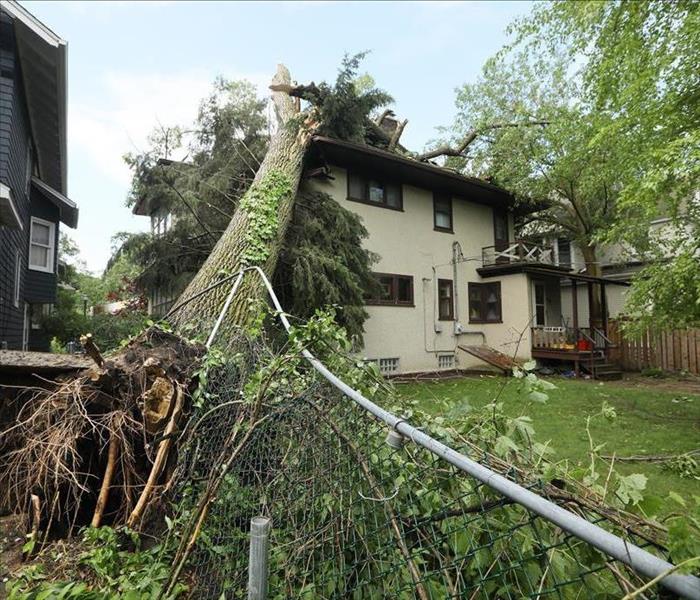 Storm Damage in Virginia Beach, VA
Storm Damage in Virginia Beach, VA
Storm damage can occur at any time and can cause an immense amount of harm to your home. Heavy rains can cause flooding and powerful winds can cause roof damage and downed trees on your property. Some post-storm damage can create safety and health hazards as well, so having a strategy to deal with damage will help you to be ready to take steps immediately after the storm.
Take Safety Precautions
Heavy winds and rain can create physical hazards such as collapsed roofing materials, window damage, collapsed walls or standing water in the basement or home interior. In addition, moisture can soak into furniture, carpeting, and building materials making the perfect environment for mold growth that can cause health issues. Shut off the main gas line if you smell gas. Beware of broken glass, exposed nails, and other sharp objects on the property. Contact SERVPRO of Virginia Beach to help do basic tasks to secure your property and make it safe to use. If necessary, arrange for an alternative place for you and your family to live while your property is being restored to safe living condition.
Photograph the Damage
If it is safe to move around your property, use your cellphone or a camera to photograph the damage so that you will have a record for your insurance company. This action will ensure that you are fully compensated.
Contact Your Insurance Company
Contact your insurance agent to notify them about the damage to your home immediately. The company will send out an adjustor to determine the extent of the damage so that payment for repairs can be made.
SERVPRO of Virginia Beach 757-431-1400
Signs of Storm Damage
12/5/2017 (Permalink)
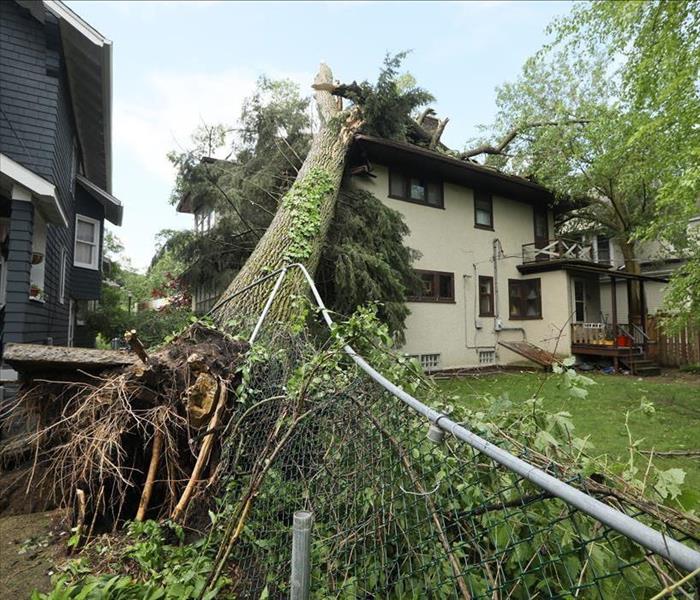 Storm Damage
Storm Damage
- Roof: Look for shingles that have discoloration, tearing, or even holes in them. These can all be signs that your roof has been damaged. Another sign is if there are leaks in your roof or your ceiling.
- Gutters: After a hail storm, looking for dents or dings can also give you a better picture of what the storm did to the rest of your home. Your gutters can also give you insight to whether you have roof damage. Check to see if there are granules from the asphalt shingles in your gutter.
- Windows: Look at each of the windows at your homes and note any signs of shattered or broken windows and frame damage. This is especially important after a hail storm or a strong wind storm.
- Exterior: Not only is it important to look at the siding of your home to check for damage, it is also important that you check any appliances. Inspect your AC/HCAC unit as well as items such as a barbeque grill.
After your inspection, if you notice any signs of storm damage follow up by checking the area for signs of mold, mildew, pests or other secondary damage. If damage has occurred have it repaired immediately. Call SERVPRO at 757-431-1400 for any restoration needs you may have.
Storm & Wind Damage
12/4/2017 (Permalink)
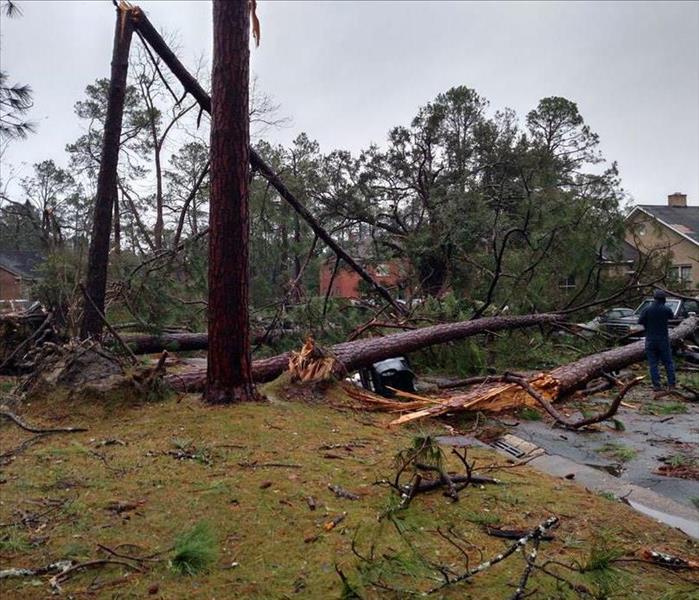 Storm Damage
Storm Damage
There are many areas of the United States that have experienced heavy winds and storms this season and the strong powerful winds can cause significant damage to a home. Wind damage and water damage are the most common results of a heavy storm and it is important to contact SERVPRO as soon as the storm is over to help limit and repair the damage. Wind damage can happen to your home directly from the strong wind or indirectly from the wind blowing debris into your house. These wind damage facts will help you better understand the potential for wind damage and how to prevent it.
Storm Damaged Roof
Wind Type Varies by Storm and Causes Different Degrees of Wind Damage
Thunderstorms are the most common source of wind and storm damage but winds from hurricanes or tornadoes are stronger and can cause more severe damage. It is important to know when a storm is approaching your area and what type of storm it is so you know the potential and level of damage to expect. Thunderstorms are responsible for over half of all wind damage cases in the U.S. but the storm damage repair may be more costly for hurricane or tornado wind damage.
Characteristics of the Wind Affect the Wind Damage
The wind has many characteristics that differ depending on the situation. Some characteristics to take into account include speed, direction, and duration of the gusts and recognizing them can help you protect your home and property effectively from wind damage. Recognizing the characteristics of the wind can also help you determine how much potential damage to expect.
Preventing Wind and Storm Damage
Most wind damage is caused by flying debris either from plants or other structures and objects that are not secured. If a storm is approaching your area, make sure any potential debris around your home such as patio furniture, toys, garbage cans, and other objects are either secured or brought inside. Your doors and windows should also be secured to help minimize the potential storm damage to the home.
Wind and Storm Damage Repair Costs
Wind damage can cause a range of destruction to your property from broken windows and fallen tree branches to more severe damage to the roof, garage, or car. Billions of dollars are spent on wind damage repair and storm damage restoration each year and understanding the nature of wind damage can help you limit the amount of damage to your home and save on restoration and repair costs. The cost of wind damage repair generally ranges from about $880 almost $11,000 with most homeowners spending on average between $4,600 and $7,000 for repairs. Make sure to contact SERVPRO for an estimate on the wind damage repair for your home.
Wind damage from different types of storms is a major cause of destruction to homes and by understanding the characteristics of wind damage, you can help keep your home protected during a storm. Different types of storms bring different types of winds and the storm damage caused by the wind can range from minor damage to more costly structural damage. If your home sustains wind damage during a storm, make sure to call SERVPRO immediately. These qualified technicians can provide effective wind damage and storm damage repair.
Please give us a call at 757-431-1400.
4 Facts About Hurricanes You Need To Know
11/16/2017 (Permalink)
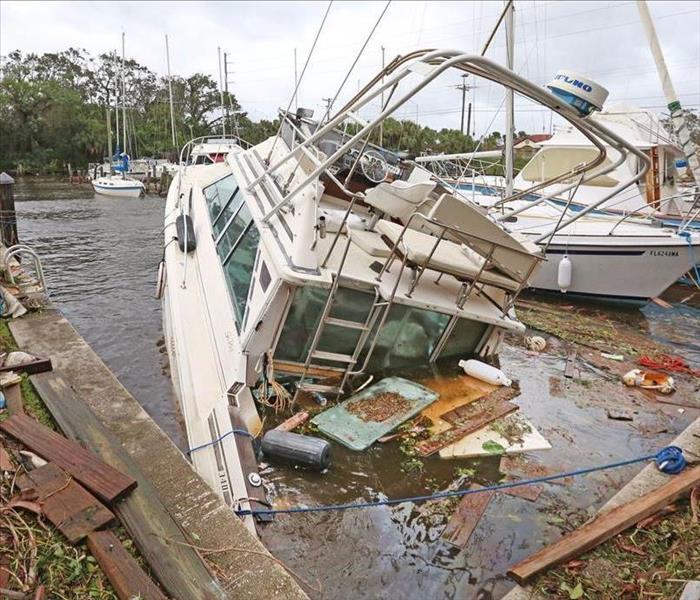 Hurricane Irma
Hurricane Irma
Hurricane season is June through November. So, here we are. Hurricane season. And though Georgia rarely gets a direct hit by a hurricane, living near the coast in the south, most people are all too familiar with the hurricane season and the tropical storms that come with it. But what about hurricane damage to your home? If you haven’t had hurricane damage before, here are 4 facts about hurricane damage you need to know before the storm hits.
1. Primary Causes of Hurricane Damage
The primary cause of hurricane damage to homes is damage from high wind and flooding from the torrential rains.
2. What the Wind Does
The wind can cause damage to siding and it can break windows and blow in garage doors. Broken and downed trees are another result of hurricane damage.
3. What the Water Does
Torrential rains can often cause flooding from overwhelmed gutters and downspouts, broken windows and damaged roofs, and saturated soil around and near your home.
4. What a Storm Damage Expert Will Do
A storm damage restoration company like SERVPRO of Virginia Beach will help you deal with hurricane damage quickly. With 24-hour emergency response and the tools and equipment to deal with the damage to trees, siding and flooding, they’re you’re one-stop-shop for hurricane damage.
Please give us a call at 757-431-1400.
Storm Facts, Tips and Safety
11/16/2017 (Permalink)
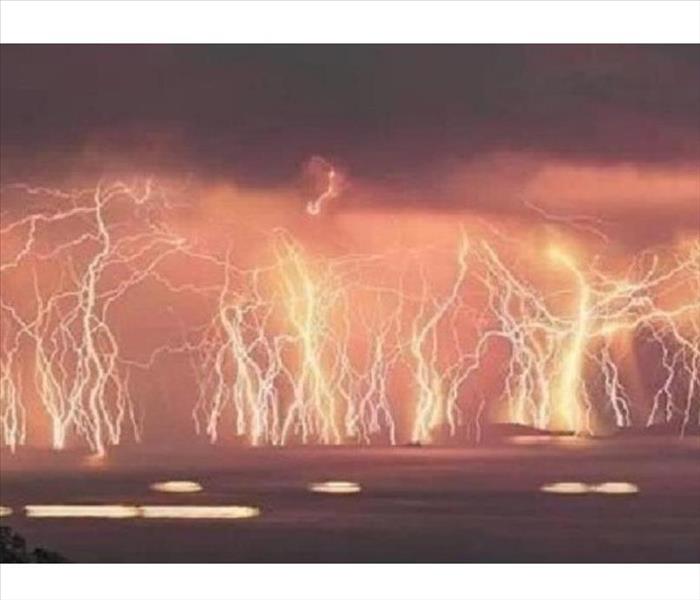 Storm Facts
Storm Facts
Severe Thunderstorm Facts
Thunderstorms are defined as storms that produce thunder and lightning. Severe thunderstorms may also produce:
- Rain
- High winds
- Sleet or snow
It’s important to note that thunderstorms do not always produce moisture. A storm in which you see lightning and hear thunder but never feel a drop of water is known as a “dry” thunderstorm. Thunderstorms that produce hail and tornadoes are known as “supercell” storms. Storms occur either in clusters or lines; therefore, they may present as a single thunderstorm or as multiple thunderstorms hitting one after the other.
Causes
Thunderstorms are caused when moisture from the lower or mid-level part of the atmosphere mixes with warm, unstable air from the ground. Moisture and air then push upwards into the higher atmosphere to form clouds that produce thunder and lightning, as well as potential precipitation. Spring, summer and fall are most conducive to thunderstorms because the sun heats the ground and moisture is more perceptible in the air, especially in humid climates.
Thunderstorms must also be lifted to begin their formation. Some sources of lift include:
- More heat on the ground than in the air
- Changes in atmospheric conditions near mountains
- Weather front changes caused by clashing cold and hot air
- Drylines, or when moist and dry air clash
- Land or sea breezes
Any of these situations can immediately create a thunderstorm without warning, even in the middle of a clear blue day. In many cases, these storms will also be accompanied by lightning. Most will not come with hail or tornadoes, unless they occur in tornado-prone states such as Kansas, Oklahoma, Texas and Missouri.
Return to Top
Thunderstorm Statistics
Severe thunderstorms are responsible for a significant number of injuries, fatalities and property damage claims across the United States every year. According to statistics reported by the National Oceanic and Atmospheric Administration (NOAA) in 2013:
- Lightning accounted for 23 fatalities, 145 injuries and $23.9 million in property damage.
- Tornadoes caused 55 fatalities, 756 injuries and $3,642.2 million in property damage.
- High winds resulted in 17 deaths, 121 injuries and $626.8 million in property damage.
- Hail led to 4 injuries and $1,234.5 million in property damage.
- Flash flooding ended in 60 deaths, 25 injuries and $956.9 million in property damage.
It’s estimated that at least 867,000 people are affected by thunderstorms every year, with lightning accounting for at least 300 injuries and roughly 60 fatalities. Moreover, at least 16 million thunderstorms occur worldwide every year — and at least 2,000 storms are causing damages and injuries around the world at any given time.
Return to Top
Preparing for Severe Thunderstorm Conditions
Severe thunderstorms can cause significant physical harm as well as damage to your home and land; therefore, it’s imperative to take measures to protect yourself. Some homeowners might invest in lightning rods to better defend their homes against a surge. There are also whole-house surge protectors so you don’t have a power outage during a severe thunderstorm. There are many other types of defenses you can put in place to protect your home against severe thunderstorms. For example, here’s how to prepare for hail, winds, tornadoes and floods.
Hail Damage
If you have a car, it’s imperative that you park it in your garage before a severe thunderstorm. Otherwise you could be looking at dents, cracks in the windshield and potentially broken glass on the driver or passenger’s side. While hail is not the most common precipitation to accompany a severe thunderstorm, it can happen. You could also:
- Install wind shutters (i.e. hurricane shutters), designed to defend against high winds and hail.
- Purchase & install pressure or high impact windows.
- Secure doors with heavy-duty bolts at the top and bottom of the door frame.
Hail can cause damage to many parts of the home, but it most commonly hits the roof the hardest. A damaged shingle, in particular, can allow water to get through to the roof deck and cause harm to your ceiling and support beams. This will eventually lead to more leaks in your roof, stains on the ceiling and walls, and potential flooding.
The cost to repair a roof following such damages will be expensive, but holding off could lead to even more costly repairs down the road. It’s best to perform repairs as quickly as possible. The two types of repairs you might be faced with include:
- Asphalt: Hail damage will appear as a dark spot or bruise because the granules will be missing. Look for holes, cracks or absent shingles. Repair immediately.
- Other shingles: Wood, metal, tile and other shingles will be hit hard by hail as well. Cracked, missing or broken shingles will allow leaking, so you’ll need a roofer in immediately to fix the problem.
Wind Damage
Winds can reach at least 300 miles per hour during a severe thunderstorm, which can rip siding off your home and exacerbate the pelting of your exterior with hail and debris as well. Wind damage repairs can cost thousands of dollars, depending on the extent of the injury. While you can’t prepare for flying debris from other houses, you can minimize damage by curtailing debris in your own yard. To prevent wind damage, you can:
- Trim back tree branches to prevent fallen limbs.
- Secure window shutters to defend against debris.
- Tie down anything that could fly away and hit the siding or the roof.
If your siding is looking worse for wear, have a siding professional come out to repair it. It could make the difference in whether you’re left with an intact home exterior after a storm or not.
Tornado Damage
Tornado damage occurs following high winds from blowing debris. While you can’t do a lot to prepare your home for a tornado, it helps to trim tree branches back from your roof and windows. You can also reinforce your roof to better handle high winds:
- Shake roof: Add more nails.
- Slate roof: Seal down with cement.
- Tile roof: Place a steel strap over the tiles.
- Asphalt roof: Nothing can be done, but inspect after.
You can also invest in a storm cellar, which is built underground and allows great defense against high winds during a tornado. A storm shelter is built close to the home so you have easy access during a tornado and don’t have to run far for safety. A storm cellar door is built at an angle so that debris blows over the door. This allows for debris to roll over the door rather than trap it, so you can get in and out easily. The confines of a storm cellar for a family is around 8 by 12 feet with an arched roof. It’s made of cement blocks and rebar to ensure maximum defenses.
Flood Damage
Flooding can cause tens of thousands of dollars in damages to your home. To prepare your home for potential flooding, ensure that the ground is sloped away from your foundation. This will defend your home against water buildup. Also, regularly maintain any storm drains, gutters and downspouts. Other tips include:
- Cleaning gutters regularly
- Check and clean storm drains on a bimonthly basis
- Clean the storm drain cover
- Check window wells and sump pumps
- Construct barriers to stop flood water from getting into your home.
- Raise your heating system to a higher floor level to avoid flood water.
- Seal cracks in the basement walls.
Return to Top
Warnings, Alerts & Where to Go
You will see severe thunderstorm warnings and alerts appear throughout the span of the storm, whether it’s on the radio, TV or your smartphone. You can find warnings:
- In emergency notifications on smartphones
- On weather apps as alerts in real time
- On the radio from the National Weather Association
- On TV at the bottom as a grey moving bar with affected counties, times
When you see a severe thunderstorm warning in effect for your area, you need to stay indoors until at least 30 minutes after the last clap of thunder. Stay away from windows and doors, in case they happen to blow open or break in high wind conditions. Stay out of water in case of lightning. If you’re driving when you get the alert, head home if you’re close or get off the road immediately.
Return to Top
Storm Recovery and Damage Repair
After a severe thunderstorm hits your home, you could be looking at a few hundred dollars worth of simple repairs — broken windows, landscape upkeep and debris removal, for example — or you could be looking at thousands of dollars in repairs due to hail damage and flooding. Survey the extent of the damage and determine whether it will cause additional long-term issues; immediately fix anything that will. Here are some common post-storm damages and how to address them:
Roof Damage
Broken tree branches, high winds, flying debris and hail can cause roof damage that will need to be addressed following a severe thunderstorm. Some signs of roof damage after a storm include:
- Holes
- Split seams
- Missing, bruised or dented shingles
- Cracked or broken tiles
- Granules in the gutters
- Leaks
- Dents on the vents and gutters or roof flashing
It’s imperative that you have a roofing contractor fix your roof following a severe thunderstorm. Otherwise, these damages could lead to expensive interior problems like attic flooding, ceiling stains, and mold. In worst-case scenarios — those in which your roof is old and cannot handle the high winds or hail storms — your roof may cave in on itself. This is uncommon, but you do run the risk of having to replace your roof if it’s reaching the 15-20 year mark around the time of a severe thunderstorm.
Siding
Weather associated with severe thunderstorms can also significantly impact the exterior and siding of your home, causing:
- Cracks that run parallel to the siding
- Chips or breaks in siding
- Breaks or holes that are punched into the siding by hail and debris
- Dings and dents, most commonly found in aluminum siding
- Paint damage such as chips, cracks and color changes or small black marks
If your siding shows cracks, chips, or dings and dents, have it repaired immediately to prevent pests, insects or climate conditions from further impacting your home. Breaks and holes, in particular, negate the siding’s ability to defend your home entirely. Such damage will require siding to be replaced by a contractor — in parts or in whole — which could cost thousands of dollars. Paint damage is the least of concerns because it’s a cosmetic injury rather than a functional one.
Windows and Doors
Windows and doors bear the brunt of severe thunderstorms’ debris and high winds, making them highly susceptible to damages. Some damages you’ll see after a storm might include:
- Cracked or splitting doors and frames
- Broken glass or shattered windows
- Debris embedded in a door or window
- Paint chipped or cracking around a door or window
Contractors recommend taking the following steps to protect your windows and doors against severe thunderstorms.:
- Window film: This keeps window glass from shattering.
- Plywood boards: Install over windows before a storm.
- Storm shutters: Shutters defend against high winds and debris.
- High impact glass: Impact glass breaks into two pieces rather than shattering when hit by debris.
Tree Damage
While you can trim your trees back before a storm, there’s still a chance that high winds, flying debris and hail will cause them to bend, twist and break during a severe thunderstorm. There are six different ways a tree can be damaged during a storm:
- Blow-over: A tree is pushed over by high winds.
- Stem failure: Stems break under high winds because of old wounds and pest damage.
- Crown twist: Tree crowns will twist and split under high winds because of poor maintenance, or because they’re lopsided.
- Root failure: Poor anchorage to the ground will cause the root to pull up or snap, and the tree will fall or lean over.
- Branch failure: Branches will break off from the tree because they’re poorly attached in the first place.
- Lightning: Lightning will hit the tree and cause small explosions down the line of the tree, causing it to break and fall.
There’s not much a homeowner can do to prep a tree for potential damage except provide good care and maintenance. Trim trees on a regular basis and try to keep branches away from your home and power lines.
Flood Damage
If your home is flooded following a severe thunderstorm, there are various steps you can take to recover your home. It’s going to be a long process, involve a lot of tearing up, remodeling and time, but your home will go back to its original state eventually. Some recommendations from the CDC include:
- Wear safety gear.
- Get rid of anything that can’t be cleaned (bedding, fabric flooring, upholstery, toys, linens)
- Throw away drywall and insulation that’s wet.
- Deep clean and scrub hard surfaces with hot water and dish detergent.
- Use fans, A/C units and dehumidifiers to speed the drying process.
- Wash all clothing touched by flood water with hot water and laundry detergent.
Be aware of electrical power lines, natural gas lines, frayed wires and any other hazards from flooding that could injure you. You should check with the gas company or the fire department before returning to your home to avoid injury. Do not return to your home during the day to avoid any accidents from being unable to see. You shouldn’t be allowed to return until the police or fire department say it’s okay. You should also not wade in standing water or around downed power lines, just in case.
If you need help with the big part of the recovery job — pulling up carpet, taking down drywall, removing appliances, so forth — you can call in a disaster recovery contractor to help you. These professionals are licensed and experienced in handling situations like flood recovery and know where to start. They can also look out for disaster-specific issues like mold, foundation issues and the like.
Return to Top
Top States for Thunderstorms
Some states are more prone to severe thunderstorms than others, which means homeowners in such states need to be better prepared. According to a report on WeatherBug, in 2013 the top states for severe thunderstorms between March 1 and June 17 included:
- Texas: 922 events*
- Oklahoma: 725 events
- Kansas: 652 events
- Missouri: 515 events
- Illinois: 456 events
- Nebraska: 405 events
- Iowa: 403 events
- New York: 252 events
- Mississippi: 233 events
- Virginia: 232 events
- Louisiana: 223 events
*Note: events are defined as severe thunderstorms
The most active states — Texas, Oklahoma, Kansas and Missouri — received 300 severe thunderstorm alerts per week.
Return to Top
Thunderstorm Safety Tips and Prevention
To keep your home and family safe before and during a thunderstorm, it’s imperative that you take precautionary measures — especially if you live in an area prone to storms.
To prepare for a thunderstorm, the Federal Emergency Management Association (FEMA) recommends:
- Putting together an emergency kit and family plan
- Removing debris and branches
- Securing outdoor objects that could blow away or damage the home
- Staying inside your home
- Closing all exterior windows and doors
- Unplugging all electronic equipment before the storm.
While there isn’t much you can do to prevent a severe thunderstorm, you can keep the damages to a minimum by securing as much in your home as possible and reinforcing the defenses around your home exterior. Tie down your roofing or seal it with mortar, call in siding professionals and clean up all the debris around your house.
There are storm damage professionals who can come in following a natural disaster and help with the recovery. While they don’t fix everything, they can help you start the process. If you want to read more about what they do, read this FAQ from the National Storm Damage Center.
How to Keep Your Insurance Down
Standard homeowner policies cover your home and what’s in it. You should be covered for storm damages and major natural disasters, including severe thunderstorms; however, flooding is not generally covered. Storm-resistance improvements that will lower your premiums include:
- Impact-resistant shingles
- High impact glass
- Storm shutters
Always file a claim following a severe thunderstorm if your home is extensively damaged.
Severe Weather Facts & Myths
11/16/2017 (Permalink)
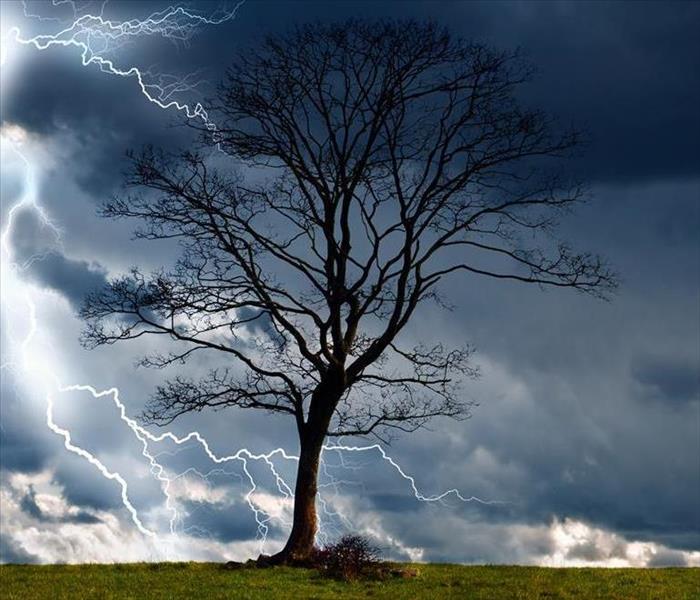 Thunder Storm
Thunder Storm
Myth: Highway and interstate overpasses are safe shelters against a tornado.
Fact: Overpasses can concentrate the tornado winds, causing them to be significantly stronger. This places the people under them in an even more dangerous situation. In recent years, several people seeking shelter beneath overpasses have been killed or severely injured. Being above ground level during a tornado is dangerous.
Myth: The low pressure with a tornado causes buildings to explode. Opening the windows will equalize the pressure, saving the building.
Fact: Opening the windows in an attempt to equalize pressure will have no effect. It is the violent winds and debris that cause most structural damage. It is more important for you to move to a safe area away from windows and exterior walls. With a tornado, every second counts, so use your time wisely and take cover.
Myth: Thunderstorms and tornadoes always move from west to east.
Fact: More often than not, thunderstorms move from west to east. Conditions in the atmosphere dictate how and where storms will move, and it can be in any direction. Tornadoes have been known to act erratic, and can change directions and speed very quickly. Never try to outrun a tornado in a vehicle.
Myth: It’s not raining here, and skies above me are clear, therefore I am safe from lightning.
Fact: Lightning can strike many miles away from the thunderstorm. If storms are in your area, but skies happen to be clear above you, that certainly does not imply you are safe from lightning. Though these “Bolts from the Blue” are infrequent, lightning strikes 10 to 15 miles away from the storm are not out of the question.
Myth: Since I am inside my house and out of the storm, I am completely safe from lightning.
Fact: Just because you have taken shelter inside, you are not automatically safe. While inside waiting out a storm, avoid using the telephone or electrical appliances and do not take showers or baths. Also stay away from doors and windows. Telephone lines, cords, plumbing, even metal window and door frames are all lightning conductors and pose a threat
Myth: Large and heavy vehicles, such as SUVs and pickups, are safe to drive through flood waters.
Fact: It is a common belief that the larger the vehicle, the deeper the water it can drive through. Many people do not realize that two feet of water can float most vehicles, including SUVs and pickups. If the water is moving rapidly, vehicles can be swept away.
Myth: Flash floods only occur along flowing streams.
Fact: Flash floods can and do occur in dry creek or river beds as well as urban areas where no streams are present.
Fun Storm Facts
11/16/2017 (Permalink)
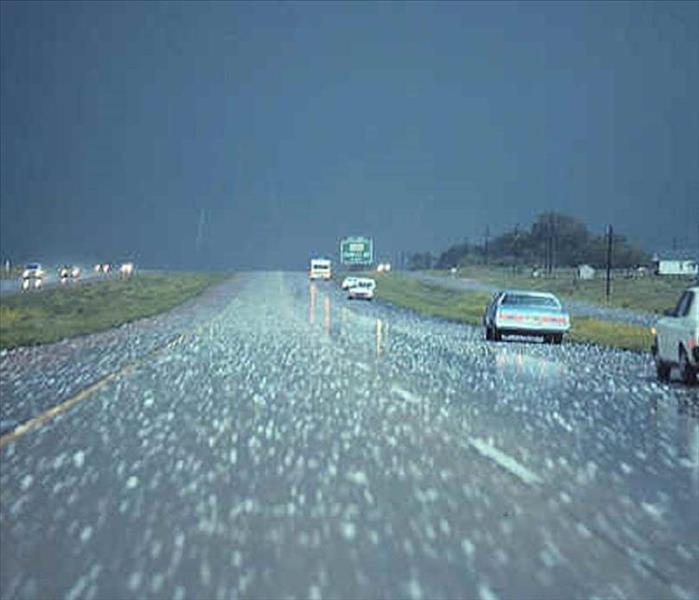 Hail Storm
Hail Storm
Are you afraid of storms, or do you embrace them? Whichever side you fall on, we all have some sort of respect for storms. They can cause great damage, paint beautiful pictures across the sky, alter any outdoor plans, and completely turn a day around. Although you’ve probably experienced many thunderstorms in your life, you might not know a whole lot about them. In today’s post, we’re going to share some fun storm facts that you may not have known!
- The typical thunderstorm is 15 miles in diameter!
- The typical thunderstorm lasts about 30 minutes.
- About 1,800 thunderstorms are happening around the world at any given moment.
- Lightning kills more people than tornadoes every year.
- A severe storm “watch” means that a serious storm has the potential to develop, but has not developed yet. However, a sever storm “warning” means that a storm has developed and been sighted.
- About 10% of storms are classified as “severe”.
- If you’re ever heard the term the “four horsemen” of thunderstorms, it’s referring to wind/tornadoes, hail, floods, and lightning.
- Thunderstorm clouds grow to heights of above 20,000 feet!
- A “derecho” is a type of severe storm that lasts a long time, covers a great distance, and involves serious wind.
- Wind speeds can be up to 120 mph in thunderstorms, even without a tornado.
- A massive hailstorm in Munich, Germany, in 1984 caused over $1 billion worth of damage.
- In 1933, huge hailstones were reported to have fallen around a city in Massachusetts, containing fresh, frozen ducks inside.
6 ways to prepare now for hurricanes
9/18/2017 (Permalink)
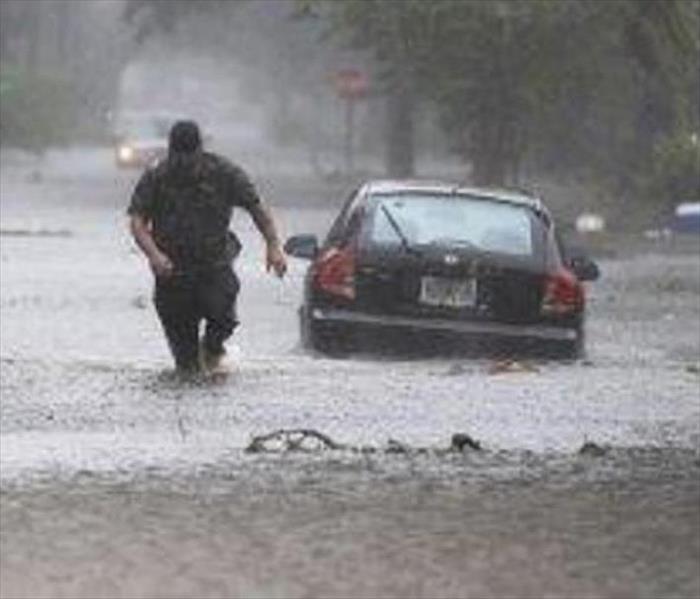 Hurricane Photo
Hurricane Photo
The worst thing that people who live along coastlines can do is not to prepare for tropical storms and hurricanes.
According to the National Hurricane Center, the two key factors contributing to weather safety during hurricanes are preparing in advance for the risks and to act on those preparations when alerted by emergency officials.
The director of the National Hurricane Center, Rick Knabb, and AccuWeather Hurricane Expert Dan Kottlowski, outlined certain precautionary steps that people in areas impacted by hurricanes and tropical storms should take.
1. Evacuation planning
The main reason people have to evacuate during hurricanes is from a storm surge, which is an abnormal rise of water generated by a storm’s winds that can reach heights well over 20 feet and can span hundreds of miles of coastlines, according to the National Hurricane Center.
"Evacuation planning is number one on the list,” Knabb said.
Knabb urged that people find out today if they live in a hurricane evacuation area, which is an area in which residents must leave their homes in the event of a hurricane.
Local governments provide the public with information about evacuation areas and the evacuation plans, and Knabb recommended that people review this information in advance.
“Some people will actually test the evacuation route in good weather,” Kottlowski said. “Waiting until the day of the hurricane isn’t a smart idea since everyone will be in a heightened state of anxiety.”
While people who live in storm surge areas fall within areas that are urged to evacuate during a hurricane, people who live outside of these zones should still look into safety precautions during a hurricane.
While evacuation shelters do provide supplies, Kottlowski said, “Shelters can get overrun and may not have enough supplies."
These kits should include water, food, blankets and clothing.
Dimitri Pinckney installs hurricane shutters in advance of Hurricane Matthew on the Isle of Palms, S.C., Wednesday, Oct. 5, 2016. (AP Photo/Mic Smith)
Car owners should also contact auto insurance companies and move their cars into an off-site location or secured building.
“You won’t be able to take every vehicle you own to the shelter, but if you leave the vehicle outside, it could be seriously damaged,” Kottlowski said.
4. Make copies of important documents
Those living in or near hurricane areas should make copies of proof of ownership documents of any property not limited to their homes, cars and boats.
These documents can be stored in the hurricane kit or in any safe location that does not risk being damaged during the hurricane.
“If a hurricane levels your house, you have to prove that it is your house,” Kottlowski said.
5. Protect your home
Residents and tenants should inspect their homes to confirm that there is no damage that a hurricane could increase.
Any issues with the overall structure should be repaired, including loose shingles or damaged roofs.
“Any possible compromises to the roof or house will become an open avenue for strong and gusty winds,” Kottlowski said.
Residences with yards should also make a list of anything laying on the ground outside that could get tossed into the air and become debris during high winds.
Kottlowski also said residents should purchase supplies, including plywood to cover windows and extra security to keep doors from blowing open, in advance, to secure their homes from damaging winds.
6. Back up your electronics
Aside from keeping extra batteries and chargers around during a hurricane, people are also encouraged to backup any electronic devices.
Knabb said data should be stored at an off-site location so that data can be recovered if something were to happen to the physical computer or device during a hurricane.
Make SERVPRO of Virginia Beach your first call to help you and your local insurance agent assess the damage. We will work for you to restore your property and your life to make it "Like it never even happened®." 757-431-1400
SERVPRO of Virginia Beach got the call to send our Disaster Recovery Team to Louisiana
9/13/2016 (Permalink)
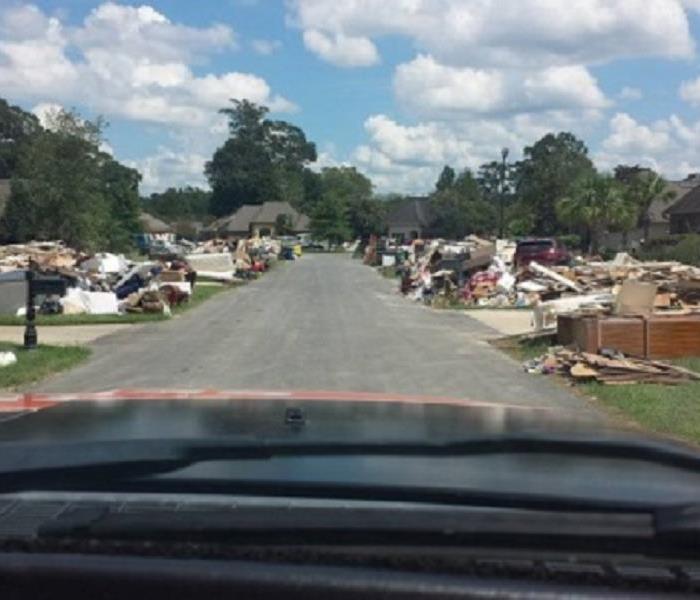 Storm Disaster on 1 street in Louisiana
Storm Disaster on 1 street in Louisiana
At first we believed we were traveling to Louisiana to help restore the flood damage
….We found we were restoring more than homes, we were restoring Lives
I am so honored to have been a part of SERVPRO of Virginia Beach’s Disaster Recovery Team and even more honored to work for a company like SERVPRO. Within hours SERVPRO had mobilized the largest restoration team to go to Louisiana. Over 2,000 SERVPRO employees, hundreds of trucks and equipment and the best experience and knowledge in the industry made way to the devastated regions of Louisiana. Most of you have heard me talk about our capabilities and strength in numbers but this time I was a part of it and experienced it first hand. To say I was WOWED is an understatement. Every corner, every road bled green and orange as SERVPROs from across the country gathered together to restore homes and lives. It was amazing to see and the best part was the hugs, smiles and thumbs up we received from the Louisiana residents. I am especially proud of the hardworking crew of SERVPRO of Virginia Beach, working 12 to 14 hour days with little sleep and a huge determination to do the job right and to quickly help those in need.
Our Disaster Recovery Team consisted of myself, Jason Cheracles, Wally Anderton, Ben Wynkoop, LaNese Holiday, Malcolm Williams, Bryce Games, Esteban Casillas, Kris Spell, Stephan Spell, Jerry Noell and Robert Kite. We aren’t just saying SERVPRO is the best, we are living it. I am a proud employee of SERVPRO of Virginia Beach. And when you need us, we will be there to make it like it never even happened.
The facts on flash floods
4/29/2013 (Permalink)
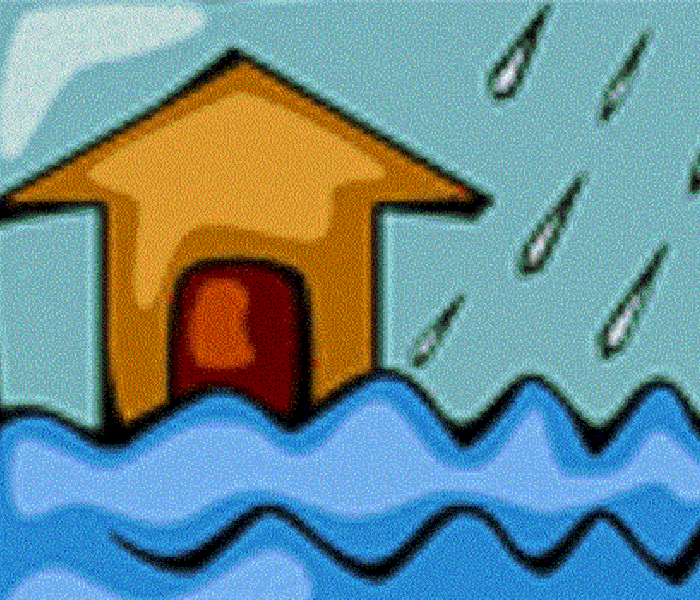
Floods are the most common and costly natural disaster. While some of Mother Nature's more demonstrative displays, such as hurricanes, tornadoes and earthquakes, get more public attention, floods are the number one weather-related killer in the U.S.
Flash Floods are the most dangerous kind of flood, combining the nearly unstoppable force of flood waters with deadly unpredictability and speed. The truth is as simple as it is tragic: Just six inches of fast-moving flood water can knock a grown man off his feet, and just two feet of water can cause a car to begin floating.
Should a flash flood strike your area, SERVPRO of Virginia Beach wants you to be equipped with the following tips to help keep you safe.
You cannot outrun a flash flood. Get to higher ground!
Stay away from and keep children away from drainage ditches and storm drains.
Never drive into water covering the road. You do not know how deep it is or if the road underneath the water has been washed away.
If your vehicle stalls, leave it immediately and seek higher ground if it is safe to do so.
Be especially cautious at night when it is difficult to recognize flood dangers
Do not attempt to cross flowing water is the water is above ankle level
Please contact SERVPRO of Virginia Beach for
Water Removal & Dehumidification
Catastrophic Storm Response
Mold Mitigation and Remediation
Fire, smoke, soot
Move outs and content restoration
Duct Cleaning
Biohazard, Crime Scene and Vandalism
SERVPRO of Virginia Beach
757-431-1400
It's always best to call us directly.
Not too crisp for a hurricane
4/29/2013 (Permalink)
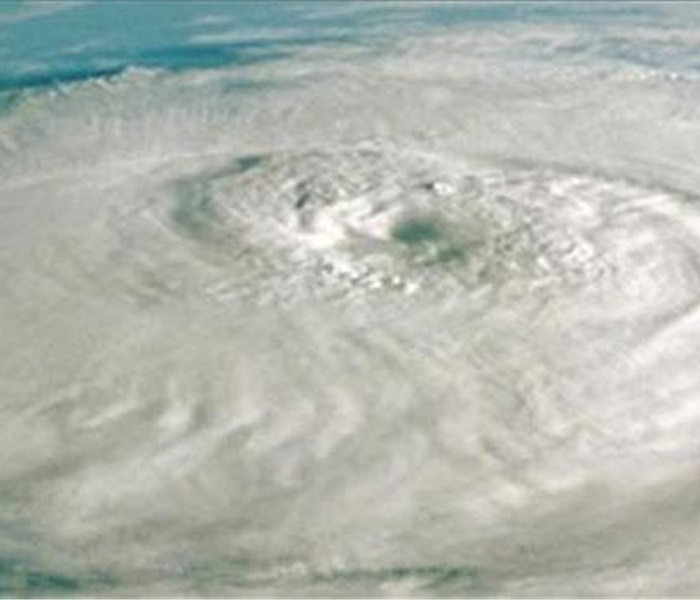
With crisper temperatures upon us, it's easy to forget that when it comes to hurricanes, we aren't out of the woods yet. Hurricane season doesn't officially end until November 30 -- so stay prepared and also remember that disasters come in all shapes and sizes and can strike at any time.
As a U.S. Department of Homeland Security National Preparedness Coalition member, SERVPRO® is committed to promoting preparedness planning and providing community resources to help prepare for emergency or disaster situations.
These tips apply to all types of disasters - whether earthquakes, floods, tornadoes, blizzards, or wildfires.
SERVPRO® Franchise Professionals want to help spread the important message on preparation to all areas and communities, no matter which corner of the country you call home. Whether you live on the East Coast, Gulf Coast, the West Coast, or anywhere in between, contact your local SERVPRO® Franchise Professionals for resources to help protect your home and business.
Write this down...
A well-equipped disaster supply kit should include, but is not limited to, the following items:
Water: 1 gallon per person daily.
Food: 3 to 7 days' worth of nonperishable or canned food, and manual can-opener.
Bedding: Blankets and pillows.
Clothing: Although the outside temperature may be warm, you may be working and cleaning. To help protect your skin, include pants and long-sleeve shirts.
First aid kit: In the very least, include sanitizers and bandages.
Cash: Keep some cash and small bills in your supply kit in case banks are closed.
SERVPRO of Virginia Beach
757-431-1400
It's always best to call us directly.
Protecting Your Property from Winter Weather
4/29/2013 (Permalink)
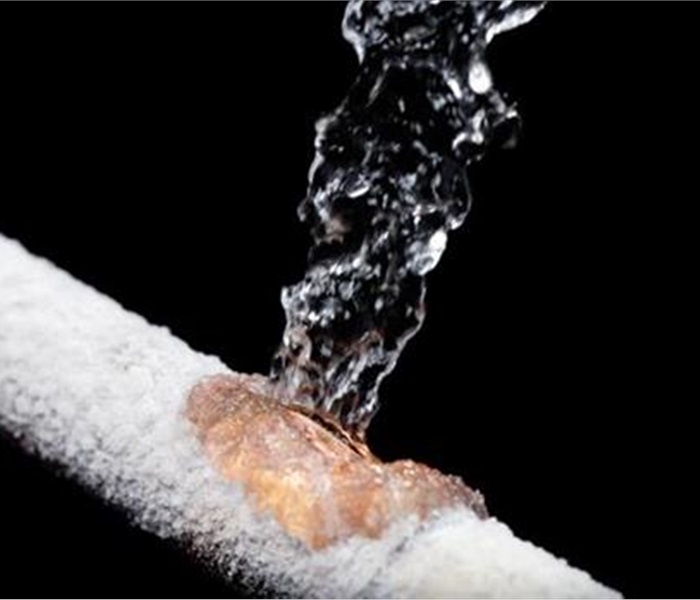
Cold weather can have a huge impact on your home or business if you are not properly prepared. Whether it is heavy rain, freezing temperatures, damaging winds, sleet or snow, all can cause serious property damage. While you can't control the weather, you can take steps to be prepared and help take the sting out of winter weather.
To help prevent costly damages due to weather, consider taking the following actions before the harsh winter weather hits.
Check your business property for downed tree limbs and branches. Weather such as wind, heavy rain, ice and snow, can cause damage to the property as well as potential personal injuries.
Inspect property, especially walkways and parking lots, for proper drainage to alleviate flood hazard potential.
Inspect all handrails, stairwells and entryways to address and correct potential slippery or hazardous areas. Install mats or non-slip surfaces and post caution signs where water could be present.
Roofs, water pipes and gutters should all be inspected to ensure they are in proper order. Gutter downspouts should be directed away from your building. Clear gutters of debris that may have gathered during the fall. Leaves and other obstructions can lead to a damming effect, that can cause roof damage and interior water problems.
Protect water pipes from freezing by simply allowing water to drip when temperatures dip below freezing. If pipes are under a cabinet, leave cabinet doors open, allowing warm air to circulate around the pipes. If the building has outdoor faucets, consider shutting water off at the main valve in the basement or crawl space. Once the valve is off, open the outdoor faucet to ensure it drains, preventing any remaining water from freezing in the pipe.
Ask your SERVPRO of Virginia Beach professional about completing an Emergency READY Profile (ERP) for your business. The ERP is a no-cost assessment to your facility and provides you with a plan to get back in business fast following a disaster.
SERVPRO of Virginia Beach
757-431-1400
It's always best to call us directly.
Snow what!
4/29/2013 (Permalink)
Snow is a lot like liver and onions. You either love it or hate it. But, if you find yourself stranded in your vehicle in the middle of a snow event, you can either hate the fact that you weren't prepared for it, or love that you are.
S'now what...
Mother nature can be a real beast. In fact, she's a killer. And when it comes to a snow event, the best idea for safety is to stay off the roads and keep warm and safe at home. However, that isn't always possible. When you find that you must venture out on snowy and icy roads, you know to stay alert, drive a little slower, brake according to road conditions... But what if your vehicle breaks down or gets stuck and you must wait for help in a disabled vehicle in dangerously cold, wet weather?
SERVPRO of Virginia Beach wants you to be prepared in the face of any hazard that may cross your path, whether flood, fire or treacherous travel conditions.
Please take a moment to look at the list (below) of suggested items to keep in your vehicle. Just a little bit of preparation can keep a little emergency from becoming a catastrophe.
Stay warm and carry on! And tune in to AM 1310 on radio to stay alert to the latest weather conditions.
SERVPRO of Virginia Beach
757-431-1400
It's always best to call us directly
Keep These Things in Your Vehicle
Cell phone
Car charger
LED flashlight
Bag of rock salt
Shovel
Wool blankets/one for each passenger
Ice scraper
Leatherman or Swiss Army knife
Jumper cables
Two quarts of oil
Extra fuses
Fix-a-Flat
Paper towels
First aid kit
Prescription and OTC medications
Winter boots, scarves, hats and heavy winter clothes for each passenger
Water
Snack bars
Toilet paper
Music/games for young passengers
Do not throw caution to the wind
4/29/2013 (Permalink)

Winds in our area have been picking up throughout the day and the National Weather Service has updated previous wind advisories and is now warning of sustained winds of 20-30 mph with gusts of up to 50 mph through 5 a.m. Thursday.
Please take a moment today to check areas around your home and business that may be particularly susceptible to wind damage. With the recent snow and up to a half an inch of rain forecast for late this evening, the wet ground could compound issues with smaller trees as well as those with shallow root systems causing trees to topple. Power lines could also be affected.
Any weather-related havoc is likely to happen overnight while folks are usually in bed so it is important to asses any potential safety hazards before the wind and rain hit.
If nothing else, maybe you'll sleep better!
Tips for avoiding wind damage from Nationwide Insurance
Shingles should meet or exceed the local building code, and be rated high for wind and impact resistance.
Make sure shingles are snugly nailed down and fitted tightly together.
Inspect the roof sheathing to ensure it is securely nailed to avoid sections being peeled off by winds.
Make sure the connection between the roof and walls is tight to avoid updrafts lifting off the roof.
Check that HVAC units, skylights and pipes are tightly affixed and won't be blown off.
About walls and doors:
Is the building well sealed to prevent wind from getting in cracks and crevices and causing interior damage?
Check all siding and windows to ensure they are tightly attached.
All entry doors should be triple hinged and secured with a deadbolt lock for maximum windstorm protection.
Overhead doors should be able to withstand high winds and braced sufficiently.
Regarding outdoor areas:
Storage sheds and outbuildings should be securely anchored.
Evaluate everything you have stored outside, such as equipment, inventory and supplies, and make sure these are anchored or can be easily moved inside if a storm approaches.
Make sure dumpsters, outdoor lighting fixtures and fencing are secured. Strong windstorms can pick up items, such as waste receptacles, and turn them into destructive missiles.
Are there large shrubs and trees close to your building? Make sure they are healthy and pruned to prevent large limbs or whole trees from falling onto your building.
Outdoor signage should be tightly anchored and secure, and designed to withstand the weather in your region. Check with your insurer to see if your sign is included in your property insurance or if you need an endorsement to cover it.
Ensure your commercial property insurance covers any damage to your building or other business property caused by a windstorm.
About vehicles and fleet:
If possible, store any vehicles inside a garage or storage building.
Never park vehicles under a tree if a storm approaches.
If you must park vehicles outdoors, be aware of things that could cause damage such as branches, lampposts and power lines.
If a windstorm approaches, consider sending fleet vehicles home with approved drivers for the business to dilute the risk of damage.
Should you encounter damage from wind or rain at your personal or business property, please call SERVPRO of Virginia Beach and let us make it Like it never even happened.
757-431-1400
It's always best to call us directly
Steps To Protect Commercial Buildings From Wind Driven Rain
4/29/2013 (Permalink)
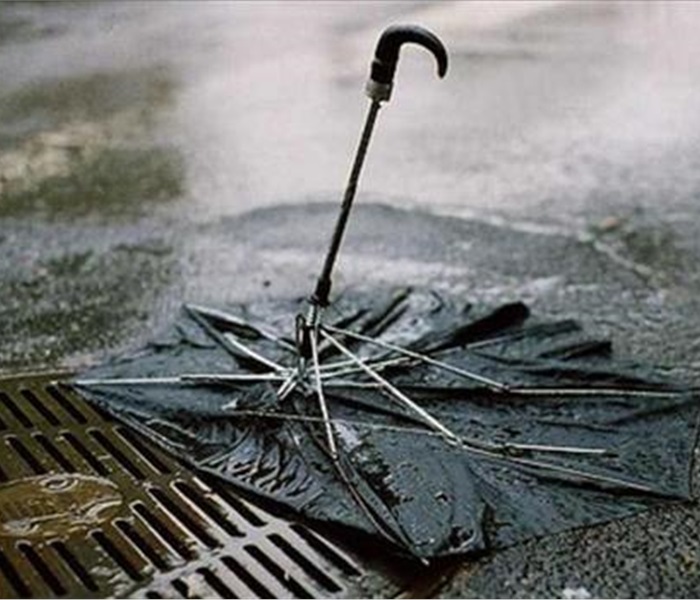
More than 60 percent of the United States is vulnerable to damage from high-wind events such as hurricanes, straight-line winds and severe thunderstorms that can produce high winds and heavy rains. Here in Hampton Roads, we are certainly susceptible to damage from strong winds and rain -- and, evidenced by recent weather events, it need not be hurricane season for us to take a wallop from wind.
Taking simple steps can make a big difference when it comes to reducing the damage caused by wind-driven rain.
Check for leaks around windows and doors, especially near corners.
Check for peeling paint, it can be a sign of water getting into the wood.
Inspect for discolorations in paint or caulking, swelling of the window or doorframe or surrounding materials.
Flashing, which is typically a thin metal strip found around doors, windows, thresholds, chimneys, and roofs, is designed to prevent water intrusion in spaces where two different building surfaces meet.
All vents, including gable vents, roof vents, and exhaust vents should be well anchored to the roof, flashed and sealed to prevent leaks.
And while the outside of the building may survive unscathed, inside water intrusion can soak documents, computers and other valuable supplies.
Water damage can threaten a business's ability to quickly bounce back after a storm. SERVPRO of Virginia Beach can help with cleanup to get your business back up and running and can assist you with future concerns by creating a plan. And it's a free service.
In addition to preparing the building against water damage, leaks can find their way in through any opening, it's important to plan for the worst before it happens. The IBHS suite of Open for Business® continuity planning and recovery tools can get you on the road to preparation. Should your building become damaged by a catastrophic event such as wind-driven rain, take appropriate actions to prevent further water damage once it is safe to do so. Water damage left unattended can result in structural failure or, potentially, mold growth. Here's what to do:
Remove standing water and all moist materials, such as wet, damaged flooring or rugs, carpet, personal property, stock, equipment or inventory, and consult SERVPRO of Virginia Beach determine the extent of the repairs necessary.
Board up damaged windows and doors.
After you have dealt with the immediate crises, contact your insurance agent to report the loss and let them know you'll be using SERVPRO of Virginia Beach for mitigation and restoration needs.
Stay dry.
SERVPRO of Virginia Beach
757-431-1400
It's always best to call us directly.





 24/7 Emergency Service
24/7 Emergency Service












